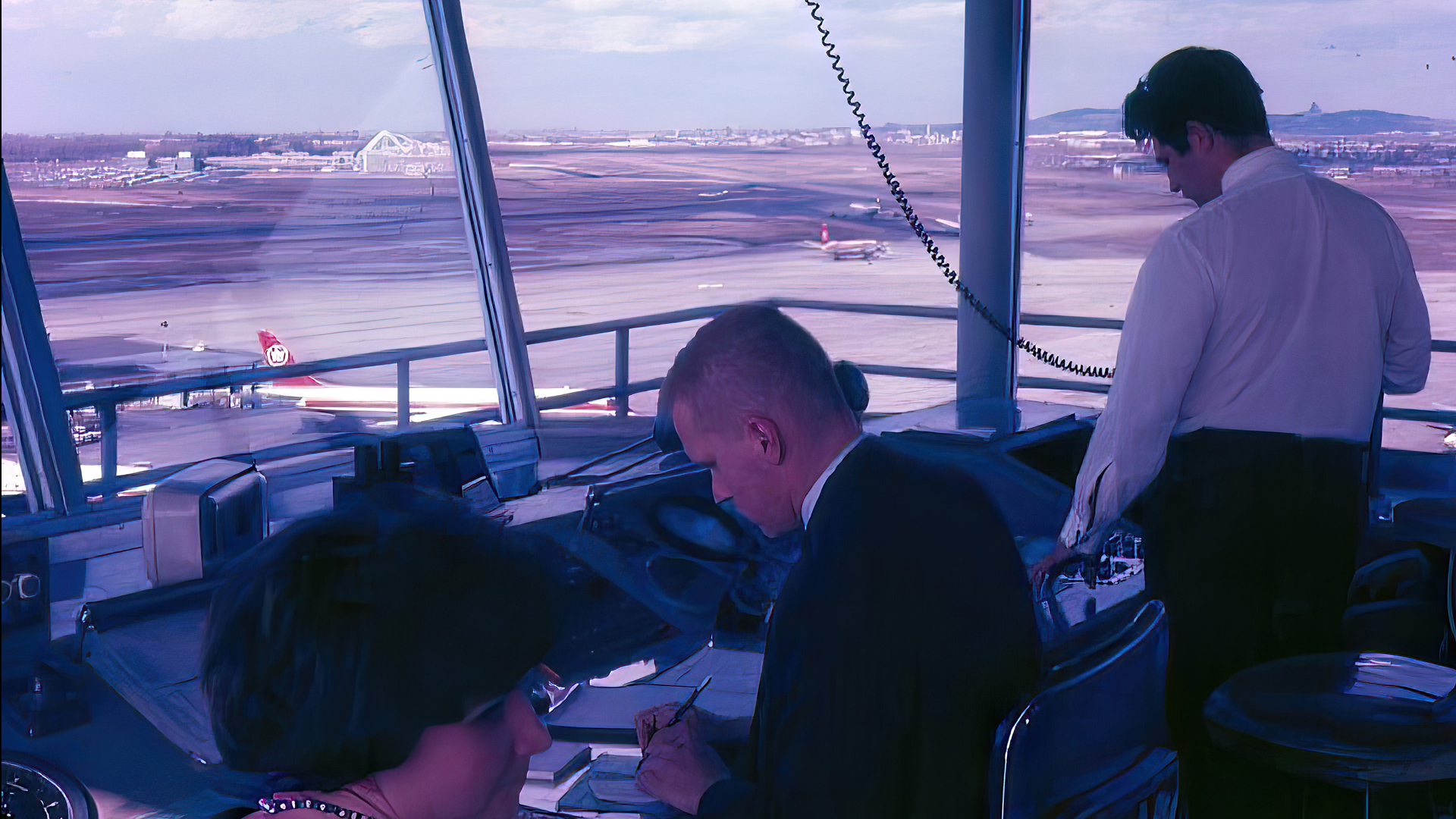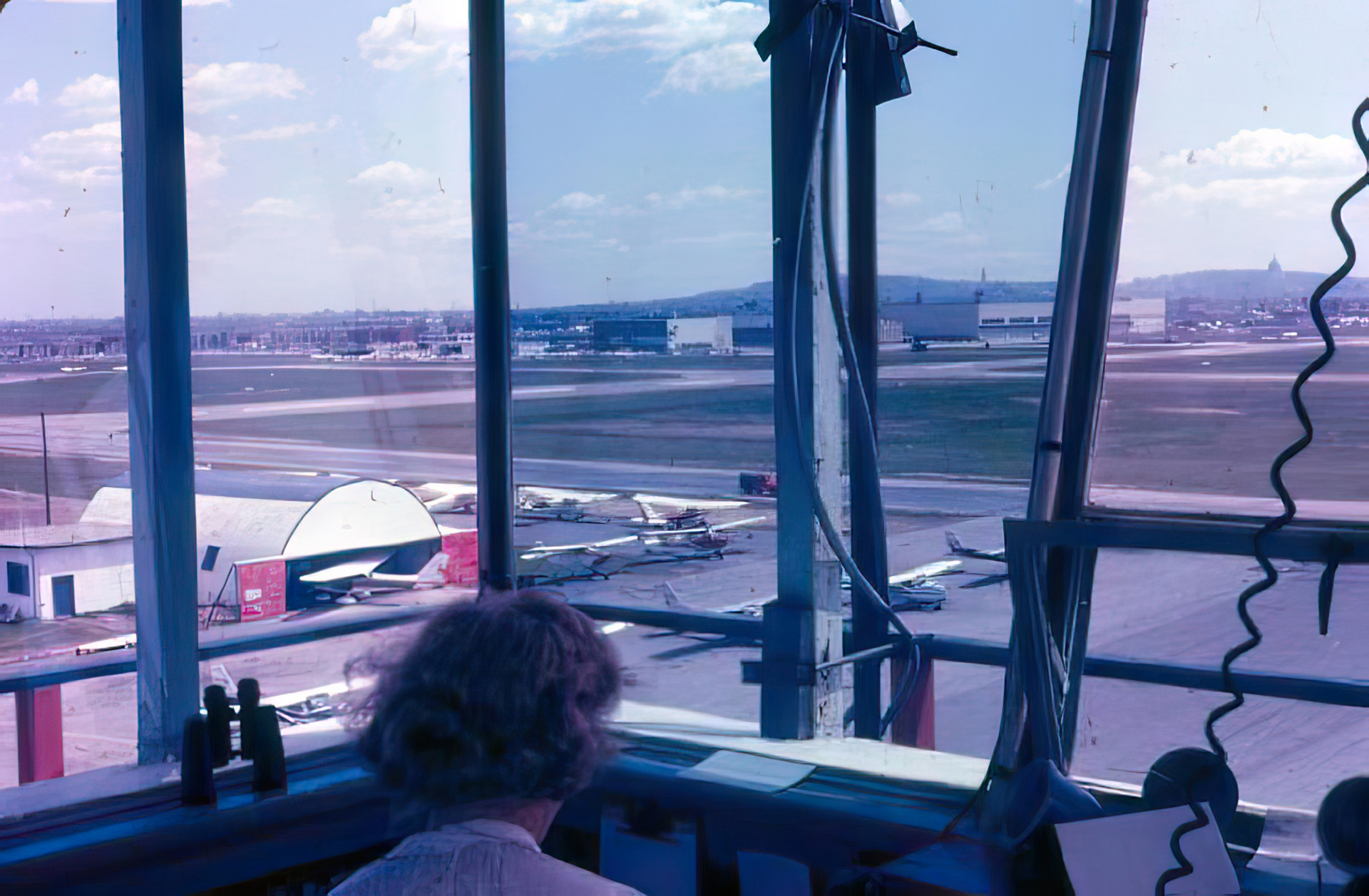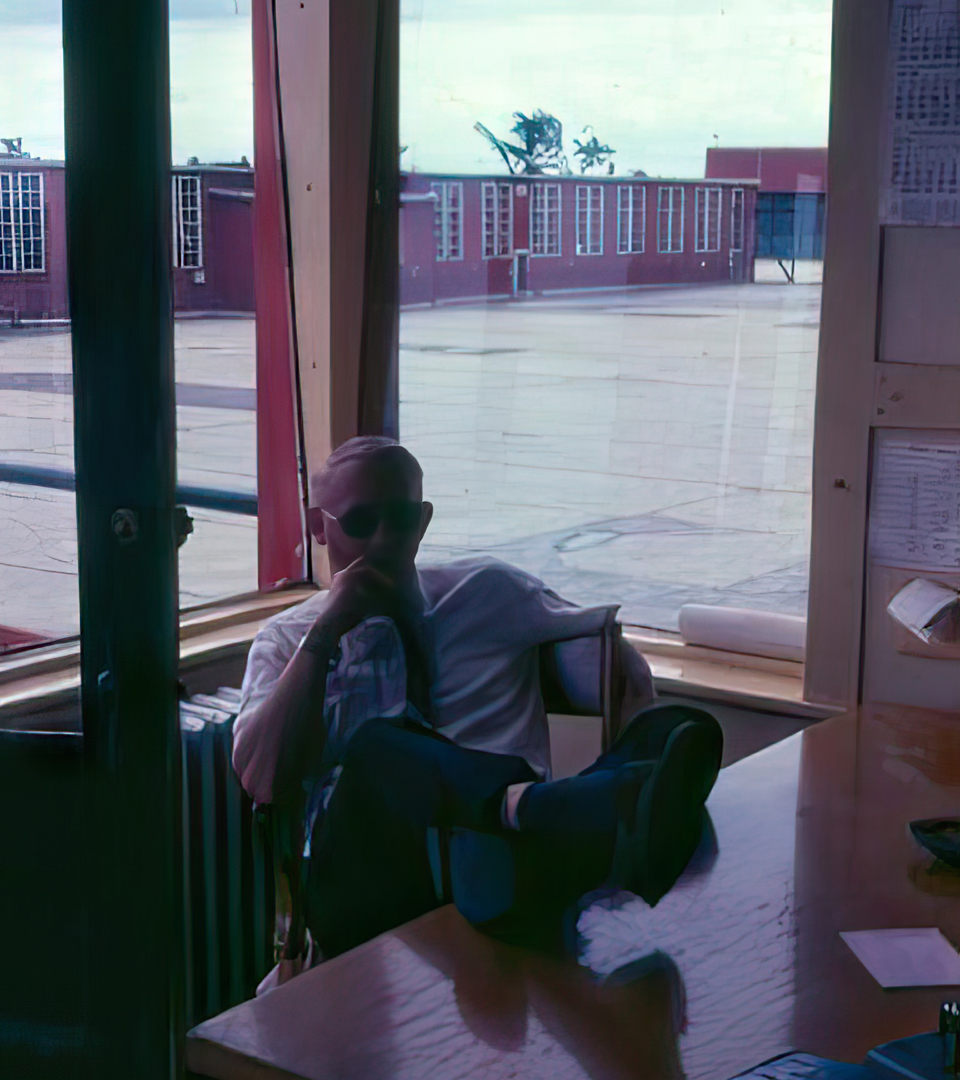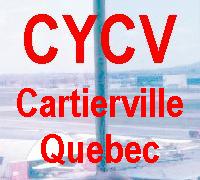
Staff Listing
Stories & Legends
Noorduyn
Norseman
Canadair
Canso
F-86 Sabre
Northstar
T-33
Argus
Cosmopolitan
Yukon
Tutor
F-104 Starfighter
Dynavert VTOL
Water Bomber
F-5 Talon
CV Aerial Photos
Cartierville
- Montreal's old VFR airport
| Louis Boisvert | Pierre Marcotte (1956) | Mac Morrell | Selwyn "Buzz" Dumaresque | Dave Wolf |
| Claude Desrochers | Stan Madore | Rene Proulx | Pete McGaurity | Luc Salvador |
| Guy Bourgie | Ron Daly | Garth Colwell | Bob Bridger | Frank Levesque |
| Frances Oneson | Fred Finney | Edna Dearden | Bob Smith | Phil Gies |
| Gilles Chalifour | Dick Lemay | Bob Willis | Bob Danziger | Gary Coffin |
All ATC units have stories and I would bet that smaller units have more than their share of stories. It's not that rules are broken, you just make things work.
One Saturday evening in the fall of '67, Canadair called to request that we stay open in the evening as they were expecting the arrival of a C-141 Starlifter right around sundown. There was a labour strike preventing parts delivery so a Starlifter (a heavy before that definition existed) was inbound with parts for Canadair's production line.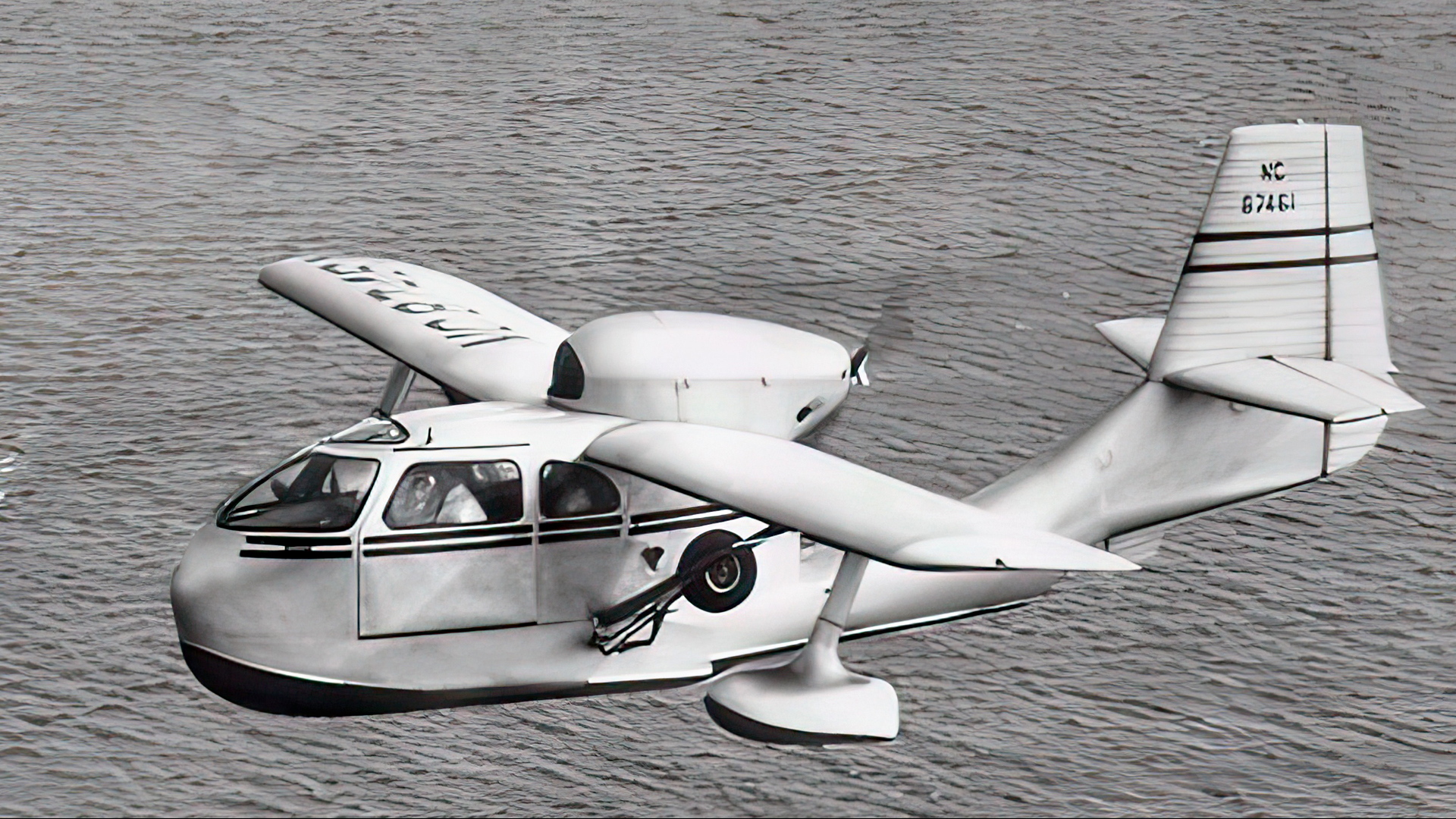 About 5:30, Lionel, the airport attendant began laying oil lamps down the north side of 28 as the longest runway did not have runway lights! Just about that time, the phone rang and a local pilot requested permission to bring in his Seabee - NORDO.
Bob Bridger approved his flight and then said to me: "Heads or tails?
About 5:30, Lionel, the airport attendant began laying oil lamps down the north side of 28 as the longest runway did not have runway lights! Just about that time, the phone rang and a local pilot requested permission to bring in his Seabee - NORDO.
Bob Bridger approved his flight and then said to me: "Heads or tails?
When I asked why, he said; "This Seabee is going to crash - every time I control one, something happens!" He lost the flip and gave the Seabee a green light to land on 28. Well, what a show! The plane landed hard and I saw one landing gear strut go flying off the runway then a shower of sparks as the Seebee skidded down the runway on its belly!
Needless to say Canadair was not pleased as this could jeopardize the Starlifter's arrival but quickly found a good solution - they dispatched a large mobile crane which picked up the Seabee and deposited it at the Montreal Flying club hangar, just to the East of the tower (the Seabee's original destination!).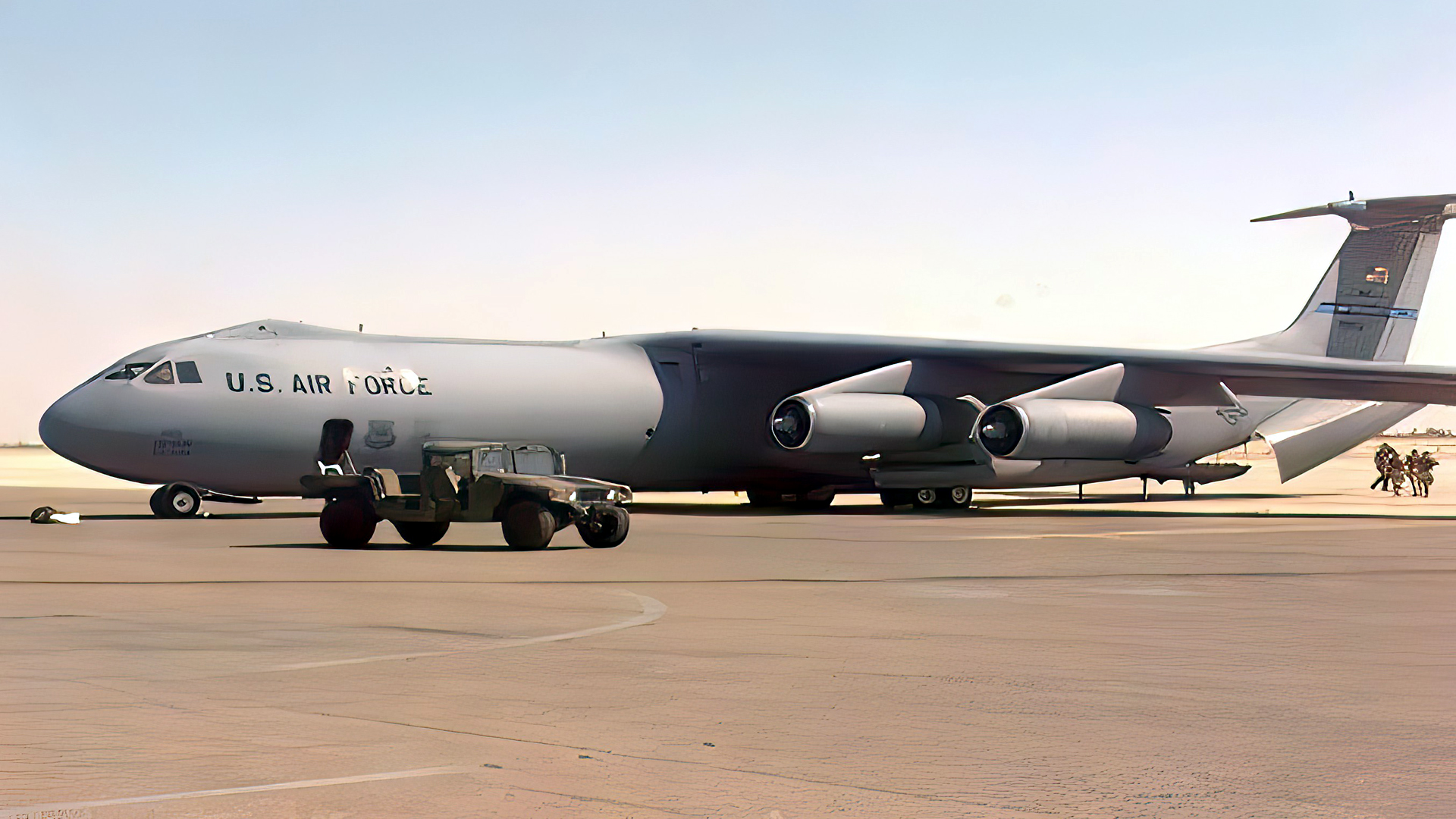
About 1/2 hour later the Starlifter landed - what a great sight!
There was no wreckage, no one was injured and there were no witnesses...
We never did report the "accident" to the MOT or the Transortation Safety Board.
Even in the '60s Dorval had a curfew - no jets between 0000 and 0700. So at 0700 things became very active. Cartierville on the other hand didn't begin operations much before 0800 even though the tower opened at 0730. It was not uncommon for flights to leave Cartierville before the tower was open if the flight had an instructor on board and was proceeding to a practice area. Typically when Cartierville opened they would give Dorval a hotline call to confirm the IFR runway in use and then they assign their circuit traffic to the same runway number. On one occasion in the fall of 1968 I was working in Dorval on the 0700-1500 shift and on this particular morning I noticed 3 or 4 airplanes doing circuits on Cartierville's 24, so I called the tower on the hotline - no answer. Binoculars confirmed there were indeed 4 aircraft in the circuit so we tuned the Bendix Transceiver to the Cartierville air frequency and we could hear Fred Finney, tower controller, issuing circuit clearances but he would not respond to hotline calls. It took a while to figure it out. Fred was also a VFR pilot so he decided to combine career and hobby - controlling and flying. He was flying circuits and clearing himself (and three others) for touch and go's. Pretty resourceful I'd say.
Because Cartierville was so close to Dorval and had similar runways, we (meaning Cartierville) maintained very strict procedures to stay clear of Dorval traffic. However it was not unusual to have Dorval traffic either interfere with Cartierville traffic or else land at Cartierville. In my own case there were several such instances and I clearly remember an Eastern DC-9 landing on Cartierville's 28. I called Dorval and had them broadcast our frequency. The Eastern captain sounded really humble and apologetic (read sheepish) and asked if we could "quietly" clear him to Dorval. "No problem, just backtrack 28 and wait 'till we suspend circuit traffic on 24 so you can get on your way." But my experiences paled to that of Rene Proulx and the Speedbird Brittania.
I don't know the year, but it must have been in the late '50s or early '60s. On the day in question, runway 28 (8800 feet) was closed for repairs so the active was 24 (less than 4000 feet). I gather the weather was marginal VFR and out of the murk appeared a BOAC Brittania on short final for 24. The plane landed and managed to stop at the intersection of 24/28.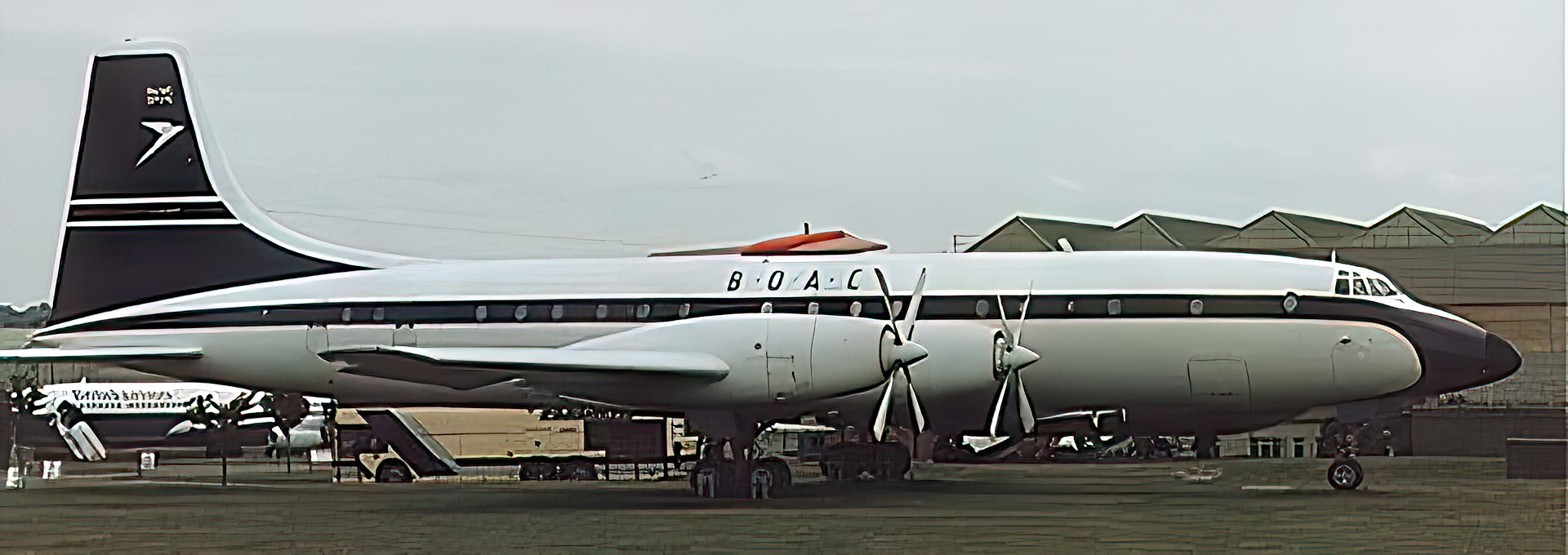 Quite a feat if you've ever seen the approach to Cartieville's 24. The threshold is about 150 feet from St. Laurent Blvd. There's the four lane road, a chain link fence, some grass, and there are no approach lights. At any rate, Rene was the tower controller and realized that this was a major deal. He arranged for the pilot to park the aircraft in front of Canadair's Plant 1, called the local police to keep the curious at bay, called Customs, and sent the tower vehicle to pick up the captain and bring him to the tower to avoid the press.
Quite a feat if you've ever seen the approach to Cartieville's 24. The threshold is about 150 feet from St. Laurent Blvd. There's the four lane road, a chain link fence, some grass, and there are no approach lights. At any rate, Rene was the tower controller and realized that this was a major deal. He arranged for the pilot to park the aircraft in front of Canadair's Plant 1, called the local police to keep the curious at bay, called Customs, and sent the tower vehicle to pick up the captain and bring him to the tower to avoid the press.
When Montreal Terminal knew from Rene that the BOAC Britannia was safely down at Cartierville, Brian McDowell, a terminal controller with a rather dry if not bizarre sense of humour, immediately called the downtown Montreal BOAC office and pretended to be a United Press reporter. He was enquiring about the new Britannia service between London and Cariterville and wanted to know the cost and schedule. They had no idea their flight was in Cartierville. Two days later the captain did his last flight for BOAC. With absolutely minimum fuel on board and no baggage, and likely no seats. he and the flight engineer flew the Britannia from Cartierville's 24 to Dorval's 24R. It was all over in less than 5 minutes.
Stan Madore writes: "BOAC did indeed land a Britannia at Cartierville. ...AND it landed long, naturally, thanks to the threshold impediments. At the time, runway 28 was being lengthened to accommodate the F104's. 28 has a pronounced hump in the middle, so you can't see one end from the other. F86's did use the old end of the runway and controllers usually gave the pilots position information on the big Miron trucks that were hauling dirt. The pilots, hearing the obvious hints, would keep it low to give the truck drivers something interesting in their lives. The drivers gradually got used to, or at least inured to, these events. As it happened, When Birdseed (ed note: Stan's lifelong name for Speedbird... ) landed, there was a Miron truck crossing the button of 06. Seeing the big bird coming at him, its engines roaring in reverse thrust, the driver did the sensible thing and, in panic, stalled the truck. Rene told me that when he got out to the scene, the driver, still seated in his cab, said to him: "You thought you could scare me, eh?" "You thought you could scare me, eh?" over and over. He had to be assisted out of the truck. There's more to this story..."
Ed Lesage writes: "... As you know, a Dorval tower check out required a controller to spend a cycle in Cartierville tower. So I too had the privilege of working there for a week. One came away with a whole new respect for that type of VFR operations. An experience that one could never fully appreciate working in Dorval tower. Where else in the world would a control tower have the ability, or the necessity to turn a red traffic light on a rural road! I remember relieving Ray Henry in Dorval tower one very early morning. He gave me the picture and as he was about to exit the tower, he said, very matter of factly; "Oh, by the way, there is a BOAC Britannia sitting in Carterville that will be coming over here today, after they strip it down". I guess I hadn't heard about it before then. Man was I surprised! I didn't know if he was joking or if this was for real."
Rob Millikin writes: "... I was not working when it happened, but can tell you my memory says it was in the 1961 or early 62, because I was living at the Mercroft Hotel on bord du lac, Dorval. One of my buddies was the base engineer for BOAC. He showed me copies of two BOAC teletypes addressed to the same person. I forget the guy's name but let's say it was Henry. I remember the content; 1st one said; "Capt Henry will fly Brittania G----- from CV to UL." 2nd one said; First Officer Henry will await the arrival of a Captain ... in UL." Sort of swift company reaction I think. You are correct, my buddy said the guy was canned when he returned to the UK (ed note; Rob's wording must be read carefully as chronologically; "... one minute he is a Captain, next minute he is a First Officer, and the last minute he is walking the street").
Luc Salvador writes: "I worked there in '62 during the F104 tests. Quite a shock when my turn came up to sit at the end of 28 checking that it was clear for them to take off. First one blew me off my feet. I had an episode with that same See-Bee mentioned in one of the articles. It had landed on 24 and it's gear folded sitting on it's floats blocking the runway. It being Sunday with no one to help I proceeded with a local guy and his truck to the aircraft and lifted it up unto it's wheels and he taxied clear of the runway. No extra pay on that."
Pete McGaurity writes: "... One sunny summer day Fred Finnie and Edna were working the circuit on runway 24 when a NORDO appeared on final on runway 33. As it was hot in the tower both windows in front were open. Edna took the Very pistol and fired a flare. It hit the pole in front and came back into the tower, bouncing off the windows, inside it passed over Edna's head and set her hair on fire. Fred fell upon her and was putting the fire out when a radio tech came thru the door and witnessed all this activity. He always took every opportunity to remind Fred of the time he caught him raping Edna.
... Rene Proulx gave the leader of the Golden Hawks aerobatic team hell because they only had time for one low pass before landing. The next day they preformed a short display up north and on returning to Cartierville, they advised px that they were going to do a small display for Rene but they had to go on a discreet frequency. They then proceeded with an airshow over Cartiervile airport on a Sunday afternoon. Everything stopped. The UL Centre supervisor called up Rene and told him to break off the show. Rene said; "I can't, they aren't on my frequency." So for 15 minutes the Golden Hawks put on a great display while everything else just sat and observed a great show. Rene got away with that one because he thought they were only going to do a low pass.
...(July 27, 1960) A PanAm B707 dropped in on runway 28 one afternoon when Rene was working. It was taxied to a discreet location on the Canadair ramp. When a PanAm representative and the captain visited the tower they asked Rene why they were not overshot. They were told that because of the heavy traffic on 24 it would have resulted in a midair. The Regional Superintendent ATC (RSATC) sent one of his henchmen over to suspend Rene. In the meantime the president of PanAm sent a wire to the head of Transport Canada, congratulating the controller for his professionalism, so Rene got a commendation instead.
... One controller in the midst of a heavy traffic situation asked for the altimeter. The console being thrown together in a haphazard fashion didn't have too many instruments permanently attached. Of course I removed the altimeter from the console and gave it to him. He broke down in a fit of laughter. So much for the serious side of controlling.
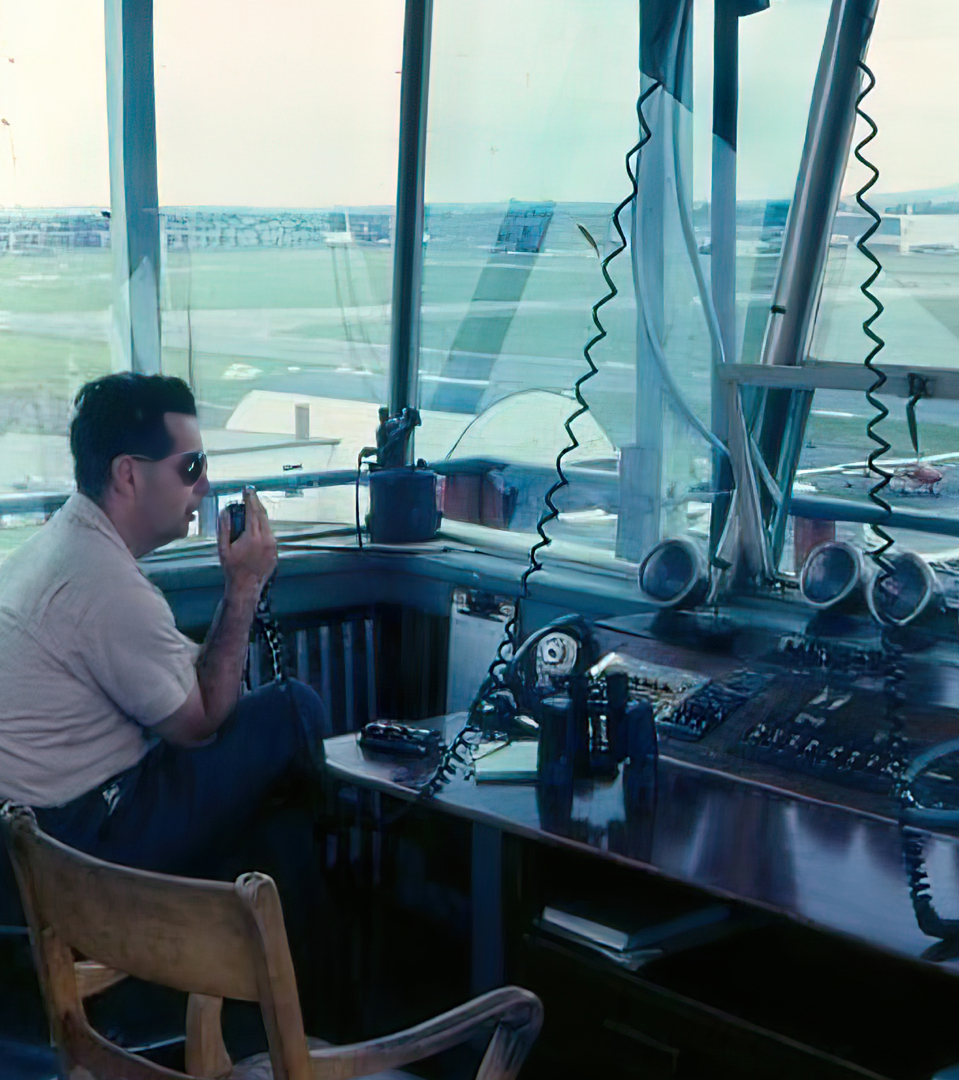 Frank Gillan was one of the test pilots for Canadair so when RCAF (excuse me, CanForce) jets needed to be test flown after repairs, Frank was generally the pilot. You always knew when Frank was flying one of the F-104s. After take-off from 28 he would do rolls before turning north or else flying just below other circuit traffic - must have been thrilling for the Cherokee pilot! Did I mention that Cartierville tower had a switch for a traffic light on Bois Franc road that we turned red whenever jet taffic departed 28. Can you imagine driving along this well treed road near an airport in the middle of nowhere without any other roads, and suddenly a traffic light turns red!! Anyway, legend has it that in the mid '60s, on one marginal VFR day (we liked IFR days - no VFR training operations at Cartierville) Frank was in the test area in a 104. He called crossing the north shore of the Back river and Bob Bridger (Cartierville air controller) advised there was no training traffic and an unrestricted low pass was approved. Observers said the noise of the rather fast 104 on final was incredible and cracked several plate glass windows of the St. Laurent shopping centre about 1/2 mile back on the approach to 24. Apparently Bob could see shock waves behind the wings of the 104 as he went by the tower and pulled an impressive right turn.
Frank Gillan was one of the test pilots for Canadair so when RCAF (excuse me, CanForce) jets needed to be test flown after repairs, Frank was generally the pilot. You always knew when Frank was flying one of the F-104s. After take-off from 28 he would do rolls before turning north or else flying just below other circuit traffic - must have been thrilling for the Cherokee pilot! Did I mention that Cartierville tower had a switch for a traffic light on Bois Franc road that we turned red whenever jet taffic departed 28. Can you imagine driving along this well treed road near an airport in the middle of nowhere without any other roads, and suddenly a traffic light turns red!! Anyway, legend has it that in the mid '60s, on one marginal VFR day (we liked IFR days - no VFR training operations at Cartierville) Frank was in the test area in a 104. He called crossing the north shore of the Back river and Bob Bridger (Cartierville air controller) advised there was no training traffic and an unrestricted low pass was approved. Observers said the noise of the rather fast 104 on final was incredible and cracked several plate glass windows of the St. Laurent shopping centre about 1/2 mile back on the approach to 24. Apparently Bob could see shock waves behind the wings of the 104 as he went by the tower and pulled an impressive right turn.
It was decided by the powers that be that both Bob and Frank could keep their jobs...
Ah, the stuff of legends...
One Saturday evening in the fall of '67, Canadair called to request that we stay open in the evening as they were expecting the arrival of a C-141 Starlifter right around sundown. There was a labour strike preventing parts delivery so a Starlifter (a heavy before that definition existed) was inbound with parts for Canadair's production line.
 About 5:30, Lionel, the airport attendant began laying oil lamps down the north side of 28 as the longest runway did not have runway lights! Just about that time, the phone rang and a local pilot requested permission to bring in his Seabee - NORDO.
Bob Bridger approved his flight and then said to me: "Heads or tails?
About 5:30, Lionel, the airport attendant began laying oil lamps down the north side of 28 as the longest runway did not have runway lights! Just about that time, the phone rang and a local pilot requested permission to bring in his Seabee - NORDO.
Bob Bridger approved his flight and then said to me: "Heads or tails?When I asked why, he said; "This Seabee is going to crash - every time I control one, something happens!" He lost the flip and gave the Seabee a green light to land on 28. Well, what a show! The plane landed hard and I saw one landing gear strut go flying off the runway then a shower of sparks as the Seebee skidded down the runway on its belly!
Needless to say Canadair was not pleased as this could jeopardize the Starlifter's arrival but quickly found a good solution - they dispatched a large mobile crane which picked up the Seabee and deposited it at the Montreal Flying club hangar, just to the East of the tower (the Seabee's original destination!).

About 1/2 hour later the Starlifter landed - what a great sight!
There was no wreckage, no one was injured and there were no witnesses...
We never did report the "accident" to the MOT or the Transortation Safety Board.
Even in the '60s Dorval had a curfew - no jets between 0000 and 0700. So at 0700 things became very active. Cartierville on the other hand didn't begin operations much before 0800 even though the tower opened at 0730. It was not uncommon for flights to leave Cartierville before the tower was open if the flight had an instructor on board and was proceeding to a practice area. Typically when Cartierville opened they would give Dorval a hotline call to confirm the IFR runway in use and then they assign their circuit traffic to the same runway number. On one occasion in the fall of 1968 I was working in Dorval on the 0700-1500 shift and on this particular morning I noticed 3 or 4 airplanes doing circuits on Cartierville's 24, so I called the tower on the hotline - no answer. Binoculars confirmed there were indeed 4 aircraft in the circuit so we tuned the Bendix Transceiver to the Cartierville air frequency and we could hear Fred Finney, tower controller, issuing circuit clearances but he would not respond to hotline calls. It took a while to figure it out. Fred was also a VFR pilot so he decided to combine career and hobby - controlling and flying. He was flying circuits and clearing himself (and three others) for touch and go's. Pretty resourceful I'd say.
Because Cartierville was so close to Dorval and had similar runways, we (meaning Cartierville) maintained very strict procedures to stay clear of Dorval traffic. However it was not unusual to have Dorval traffic either interfere with Cartierville traffic or else land at Cartierville. In my own case there were several such instances and I clearly remember an Eastern DC-9 landing on Cartierville's 28. I called Dorval and had them broadcast our frequency. The Eastern captain sounded really humble and apologetic (read sheepish) and asked if we could "quietly" clear him to Dorval. "No problem, just backtrack 28 and wait 'till we suspend circuit traffic on 24 so you can get on your way." But my experiences paled to that of Rene Proulx and the Speedbird Brittania.
I don't know the year, but it must have been in the late '50s or early '60s. On the day in question, runway 28 (8800 feet) was closed for repairs so the active was 24 (less than 4000 feet). I gather the weather was marginal VFR and out of the murk appeared a BOAC Brittania on short final for 24. The plane landed and managed to stop at the intersection of 24/28.
 Quite a feat if you've ever seen the approach to Cartieville's 24. The threshold is about 150 feet from St. Laurent Blvd. There's the four lane road, a chain link fence, some grass, and there are no approach lights. At any rate, Rene was the tower controller and realized that this was a major deal. He arranged for the pilot to park the aircraft in front of Canadair's Plant 1, called the local police to keep the curious at bay, called Customs, and sent the tower vehicle to pick up the captain and bring him to the tower to avoid the press.
Quite a feat if you've ever seen the approach to Cartieville's 24. The threshold is about 150 feet from St. Laurent Blvd. There's the four lane road, a chain link fence, some grass, and there are no approach lights. At any rate, Rene was the tower controller and realized that this was a major deal. He arranged for the pilot to park the aircraft in front of Canadair's Plant 1, called the local police to keep the curious at bay, called Customs, and sent the tower vehicle to pick up the captain and bring him to the tower to avoid the press.When Montreal Terminal knew from Rene that the BOAC Britannia was safely down at Cartierville, Brian McDowell, a terminal controller with a rather dry if not bizarre sense of humour, immediately called the downtown Montreal BOAC office and pretended to be a United Press reporter. He was enquiring about the new Britannia service between London and Cariterville and wanted to know the cost and schedule. They had no idea their flight was in Cartierville. Two days later the captain did his last flight for BOAC. With absolutely minimum fuel on board and no baggage, and likely no seats. he and the flight engineer flew the Britannia from Cartierville's 24 to Dorval's 24R. It was all over in less than 5 minutes.
Stan Madore writes: "BOAC did indeed land a Britannia at Cartierville. ...AND it landed long, naturally, thanks to the threshold impediments. At the time, runway 28 was being lengthened to accommodate the F104's. 28 has a pronounced hump in the middle, so you can't see one end from the other. F86's did use the old end of the runway and controllers usually gave the pilots position information on the big Miron trucks that were hauling dirt. The pilots, hearing the obvious hints, would keep it low to give the truck drivers something interesting in their lives. The drivers gradually got used to, or at least inured to, these events. As it happened, When Birdseed (ed note: Stan's lifelong name for Speedbird... ) landed, there was a Miron truck crossing the button of 06. Seeing the big bird coming at him, its engines roaring in reverse thrust, the driver did the sensible thing and, in panic, stalled the truck. Rene told me that when he got out to the scene, the driver, still seated in his cab, said to him: "You thought you could scare me, eh?" "You thought you could scare me, eh?" over and over. He had to be assisted out of the truck. There's more to this story..."
Ed Lesage writes: "... As you know, a Dorval tower check out required a controller to spend a cycle in Cartierville tower. So I too had the privilege of working there for a week. One came away with a whole new respect for that type of VFR operations. An experience that one could never fully appreciate working in Dorval tower. Where else in the world would a control tower have the ability, or the necessity to turn a red traffic light on a rural road! I remember relieving Ray Henry in Dorval tower one very early morning. He gave me the picture and as he was about to exit the tower, he said, very matter of factly; "Oh, by the way, there is a BOAC Britannia sitting in Carterville that will be coming over here today, after they strip it down". I guess I hadn't heard about it before then. Man was I surprised! I didn't know if he was joking or if this was for real."
Rob Millikin writes: "... I was not working when it happened, but can tell you my memory says it was in the 1961 or early 62, because I was living at the Mercroft Hotel on bord du lac, Dorval. One of my buddies was the base engineer for BOAC. He showed me copies of two BOAC teletypes addressed to the same person. I forget the guy's name but let's say it was Henry. I remember the content; 1st one said; "Capt Henry will fly Brittania G----- from CV to UL." 2nd one said; First Officer Henry will await the arrival of a Captain ... in UL." Sort of swift company reaction I think. You are correct, my buddy said the guy was canned when he returned to the UK (ed note; Rob's wording must be read carefully as chronologically; "... one minute he is a Captain, next minute he is a First Officer, and the last minute he is walking the street").
Luc Salvador writes: "I worked there in '62 during the F104 tests. Quite a shock when my turn came up to sit at the end of 28 checking that it was clear for them to take off. First one blew me off my feet. I had an episode with that same See-Bee mentioned in one of the articles. It had landed on 24 and it's gear folded sitting on it's floats blocking the runway. It being Sunday with no one to help I proceeded with a local guy and his truck to the aircraft and lifted it up unto it's wheels and he taxied clear of the runway. No extra pay on that."
Pete McGaurity writes: "... One sunny summer day Fred Finnie and Edna were working the circuit on runway 24 when a NORDO appeared on final on runway 33. As it was hot in the tower both windows in front were open. Edna took the Very pistol and fired a flare. It hit the pole in front and came back into the tower, bouncing off the windows, inside it passed over Edna's head and set her hair on fire. Fred fell upon her and was putting the fire out when a radio tech came thru the door and witnessed all this activity. He always took every opportunity to remind Fred of the time he caught him raping Edna.
... Rene Proulx gave the leader of the Golden Hawks aerobatic team hell because they only had time for one low pass before landing. The next day they preformed a short display up north and on returning to Cartierville, they advised px that they were going to do a small display for Rene but they had to go on a discreet frequency. They then proceeded with an airshow over Cartiervile airport on a Sunday afternoon. Everything stopped. The UL Centre supervisor called up Rene and told him to break off the show. Rene said; "I can't, they aren't on my frequency." So for 15 minutes the Golden Hawks put on a great display while everything else just sat and observed a great show. Rene got away with that one because he thought they were only going to do a low pass.
...(July 27, 1960) A PanAm B707 dropped in on runway 28 one afternoon when Rene was working. It was taxied to a discreet location on the Canadair ramp. When a PanAm representative and the captain visited the tower they asked Rene why they were not overshot. They were told that because of the heavy traffic on 24 it would have resulted in a midair. The Regional Superintendent ATC (RSATC) sent one of his henchmen over to suspend Rene. In the meantime the president of PanAm sent a wire to the head of Transport Canada, congratulating the controller for his professionalism, so Rene got a commendation instead.
... One controller in the midst of a heavy traffic situation asked for the altimeter. The console being thrown together in a haphazard fashion didn't have too many instruments permanently attached. Of course I removed the altimeter from the console and gave it to him. He broke down in a fit of laughter. So much for the serious side of controlling.
 Frank Gillan was one of the test pilots for Canadair so when RCAF (excuse me, CanForce) jets needed to be test flown after repairs, Frank was generally the pilot. You always knew when Frank was flying one of the F-104s. After take-off from 28 he would do rolls before turning north or else flying just below other circuit traffic - must have been thrilling for the Cherokee pilot! Did I mention that Cartierville tower had a switch for a traffic light on Bois Franc road that we turned red whenever jet taffic departed 28. Can you imagine driving along this well treed road near an airport in the middle of nowhere without any other roads, and suddenly a traffic light turns red!! Anyway, legend has it that in the mid '60s, on one marginal VFR day (we liked IFR days - no VFR training operations at Cartierville) Frank was in the test area in a 104. He called crossing the north shore of the Back river and Bob Bridger (Cartierville air controller) advised there was no training traffic and an unrestricted low pass was approved. Observers said the noise of the rather fast 104 on final was incredible and cracked several plate glass windows of the St. Laurent shopping centre about 1/2 mile back on the approach to 24. Apparently Bob could see shock waves behind the wings of the 104 as he went by the tower and pulled an impressive right turn.
Frank Gillan was one of the test pilots for Canadair so when RCAF (excuse me, CanForce) jets needed to be test flown after repairs, Frank was generally the pilot. You always knew when Frank was flying one of the F-104s. After take-off from 28 he would do rolls before turning north or else flying just below other circuit traffic - must have been thrilling for the Cherokee pilot! Did I mention that Cartierville tower had a switch for a traffic light on Bois Franc road that we turned red whenever jet taffic departed 28. Can you imagine driving along this well treed road near an airport in the middle of nowhere without any other roads, and suddenly a traffic light turns red!! Anyway, legend has it that in the mid '60s, on one marginal VFR day (we liked IFR days - no VFR training operations at Cartierville) Frank was in the test area in a 104. He called crossing the north shore of the Back river and Bob Bridger (Cartierville air controller) advised there was no training traffic and an unrestricted low pass was approved. Observers said the noise of the rather fast 104 on final was incredible and cracked several plate glass windows of the St. Laurent shopping centre about 1/2 mile back on the approach to 24. Apparently Bob could see shock waves behind the wings of the 104 as he went by the tower and pulled an impressive right turn.It was decided by the powers that be that both Bob and Frank could keep their jobs...
Ah, the stuff of legends...
History of Aircraft Production at Cartierville Airport
Saint-Laurent's relatively flat landscape attracted aviators in the 1920's to a site called "Cartierville Airport" even though the airfield was in Saint-Laurent. In 1935 Noorduyn Aviation began building planes there and had as many as 12,000 employees during the War. In 1942 Vickers built a huge plant to manufacture aircraft and other specialized transportation equipment. As Canadair, it became the hub of Saint-Laurent's thriving aerospace industry.
1937 - By the fall of 1934, Robert Noorduyn felt that it was time to design and produce an aircraft
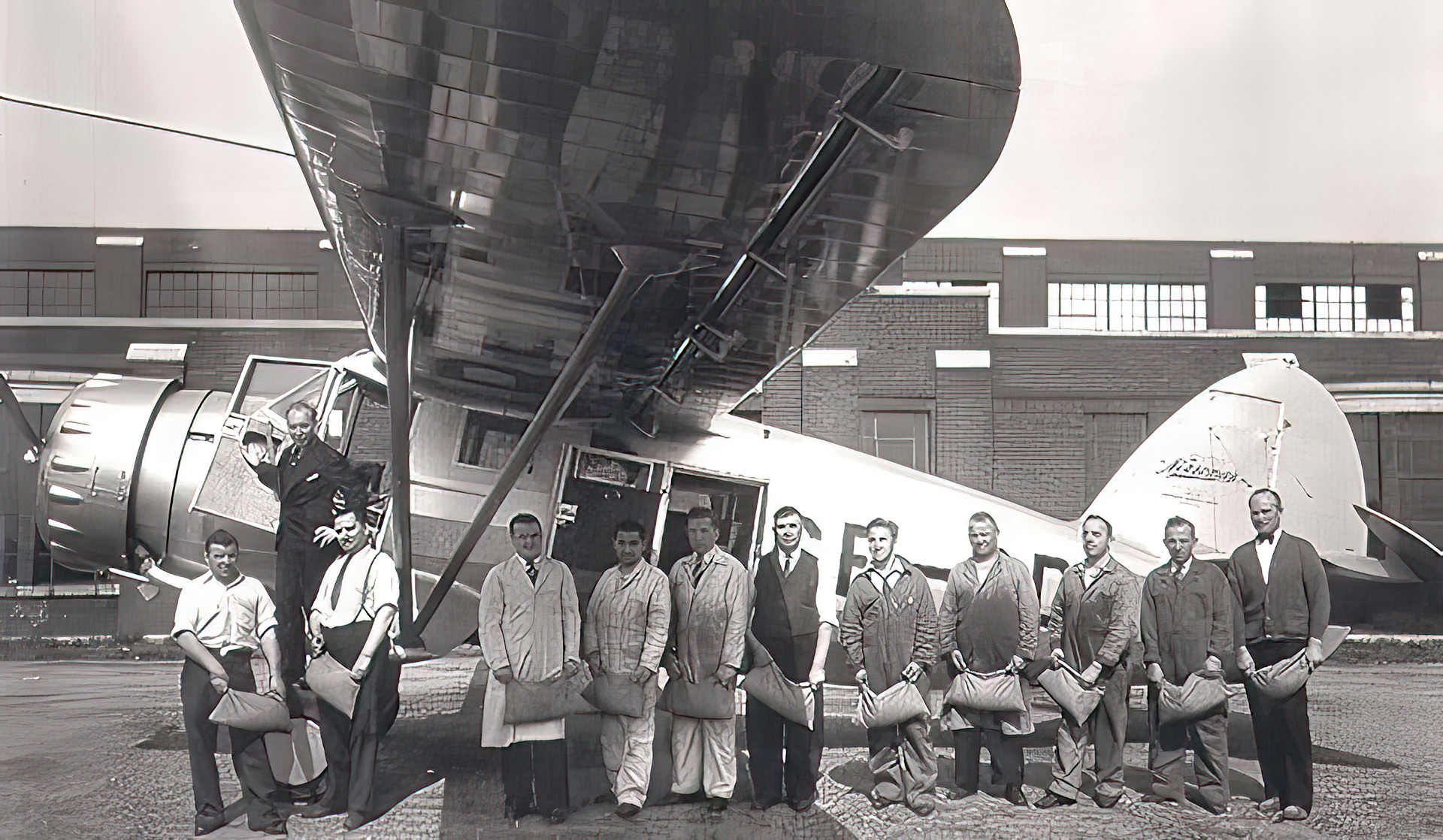 for the Canadian market that would reflect all of the lessons learned from Fokker and Bellanca aircraft performance and would fulfill a need in the then growing market for aircraft there. To accomplish this goal, it should be an aircraft which a Canadian operator with existing talents, equipment and facilities could make money, and it should be a high wing monoplane to facilitate loading and unloading of passengers and cargo at seaplane docks and airports. Finally, it should be an all around better aircraft than those presently in use in Canada.
for the Canadian market that would reflect all of the lessons learned from Fokker and Bellanca aircraft performance and would fulfill a need in the then growing market for aircraft there. To accomplish this goal, it should be an aircraft which a Canadian operator with existing talents, equipment and facilities could make money, and it should be a high wing monoplane to facilitate loading and unloading of passengers and cargo at seaplane docks and airports. Finally, it should be an all around better aircraft than those presently in use in Canada.
The first Norseman was flight tested on floats 14 November 1935 and was sold and delivered to Dominion Skyways Ltd. on 18 January 1936. Since that time, a total of 903 Norseman aircraft have been sold and delivered to various commercial customers, the Royal Canadian Air Force and the United States Air Force. Norseman aircraft are known to have been registered and/or operated in 68 Countries throughout the world and also have been based and flown on the Arctic and Antarctic continents. The last Norseman built was sold and delivered to a commercial customer on 19 January 1959. Approximately 18 Norseman aircraft are still in use. Robert Noorduyn died at his home in South Burlington, Vermont on 22 February 1959. Every July, Red Lake Ontario hosts the Norseman Floatplane Festival.Worth a visit as the number of Norsemans decreases every couple of years...
 for the Canadian market that would reflect all of the lessons learned from Fokker and Bellanca aircraft performance and would fulfill a need in the then growing market for aircraft there. To accomplish this goal, it should be an aircraft which a Canadian operator with existing talents, equipment and facilities could make money, and it should be a high wing monoplane to facilitate loading and unloading of passengers and cargo at seaplane docks and airports. Finally, it should be an all around better aircraft than those presently in use in Canada.
for the Canadian market that would reflect all of the lessons learned from Fokker and Bellanca aircraft performance and would fulfill a need in the then growing market for aircraft there. To accomplish this goal, it should be an aircraft which a Canadian operator with existing talents, equipment and facilities could make money, and it should be a high wing monoplane to facilitate loading and unloading of passengers and cargo at seaplane docks and airports. Finally, it should be an all around better aircraft than those presently in use in Canada.The first Norseman was flight tested on floats 14 November 1935 and was sold and delivered to Dominion Skyways Ltd. on 18 January 1936. Since that time, a total of 903 Norseman aircraft have been sold and delivered to various commercial customers, the Royal Canadian Air Force and the United States Air Force. Norseman aircraft are known to have been registered and/or operated in 68 Countries throughout the world and also have been based and flown on the Arctic and Antarctic continents. The last Norseman built was sold and delivered to a commercial customer on 19 January 1959. Approximately 18 Norseman aircraft are still in use. Robert Noorduyn died at his home in South Burlington, Vermont on 22 February 1959. Every July, Red Lake Ontario hosts the Norseman Floatplane Festival.Worth a visit as the number of Norsemans decreases every couple of years...
Canadair (now Bombardier)
On July 25, 1941, DND awarded Vickers a contract for 39 Cansos (the name the RCAF had chosen for the
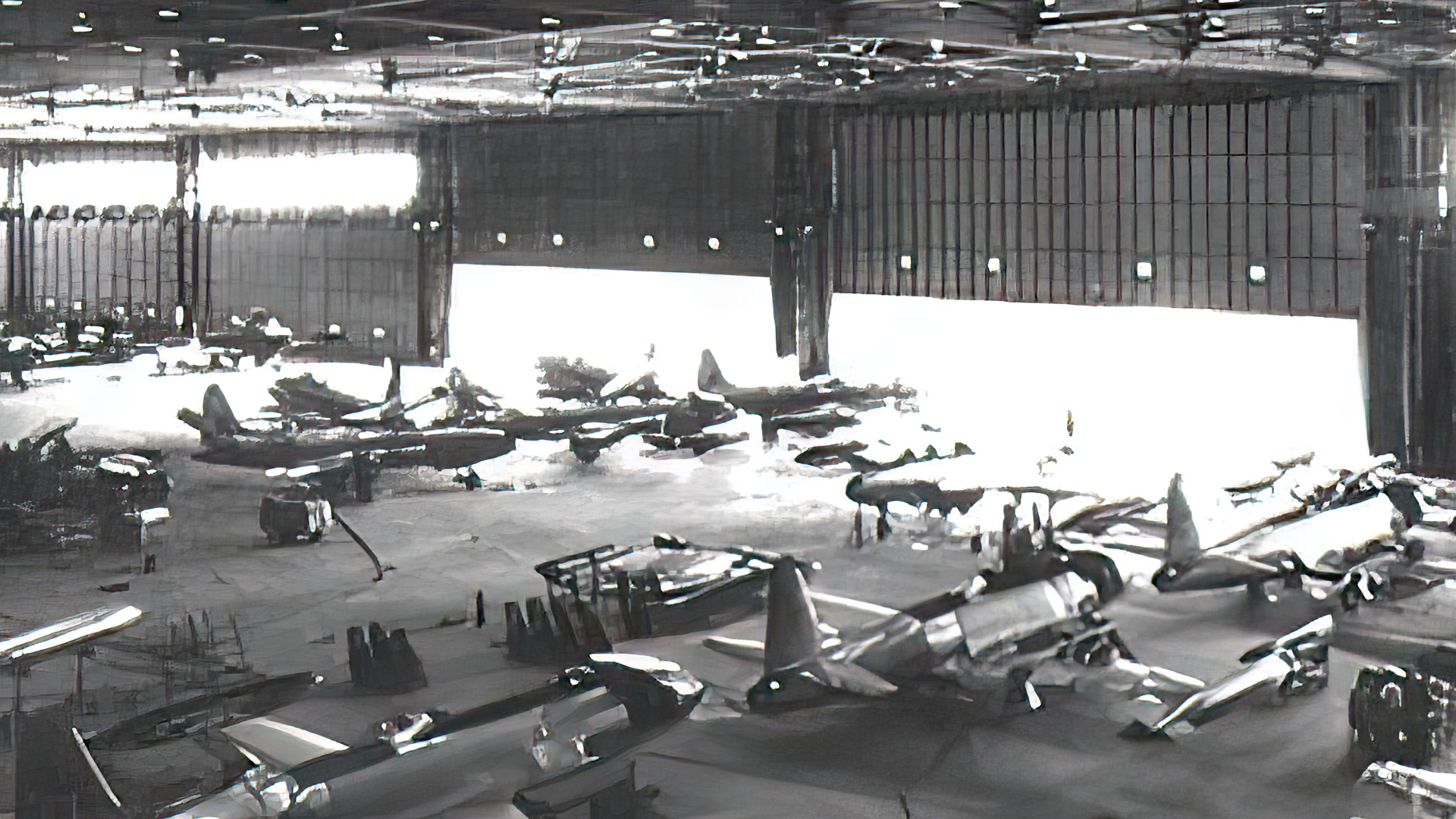 aircraft). A few weeks later, the government asked Vickers to plan and supervise the construction of a new production facility in the Montreal area which, when completed, Vickers would manage on the government’s behalf. The site chosen was Cartierville Airport in suburban Ville St. Laurent. Because space at Vickers’ Montreal shipyard was limited, the first 25 Cansos were assembled at St. Hubert airport, across the St. Lawrence River from Montreal. Work on the Cartierville plant began in
aircraft). A few weeks later, the government asked Vickers to plan and supervise the construction of a new production facility in the Montreal area which, when completed, Vickers would manage on the government’s behalf. The site chosen was Cartierville Airport in suburban Ville St. Laurent. Because space at Vickers’ Montreal shipyard was limited, the first 25 Cansos were assembled at St. Hubert airport, across the St. Lawrence River from Montreal. Work on the Cartierville plant began in
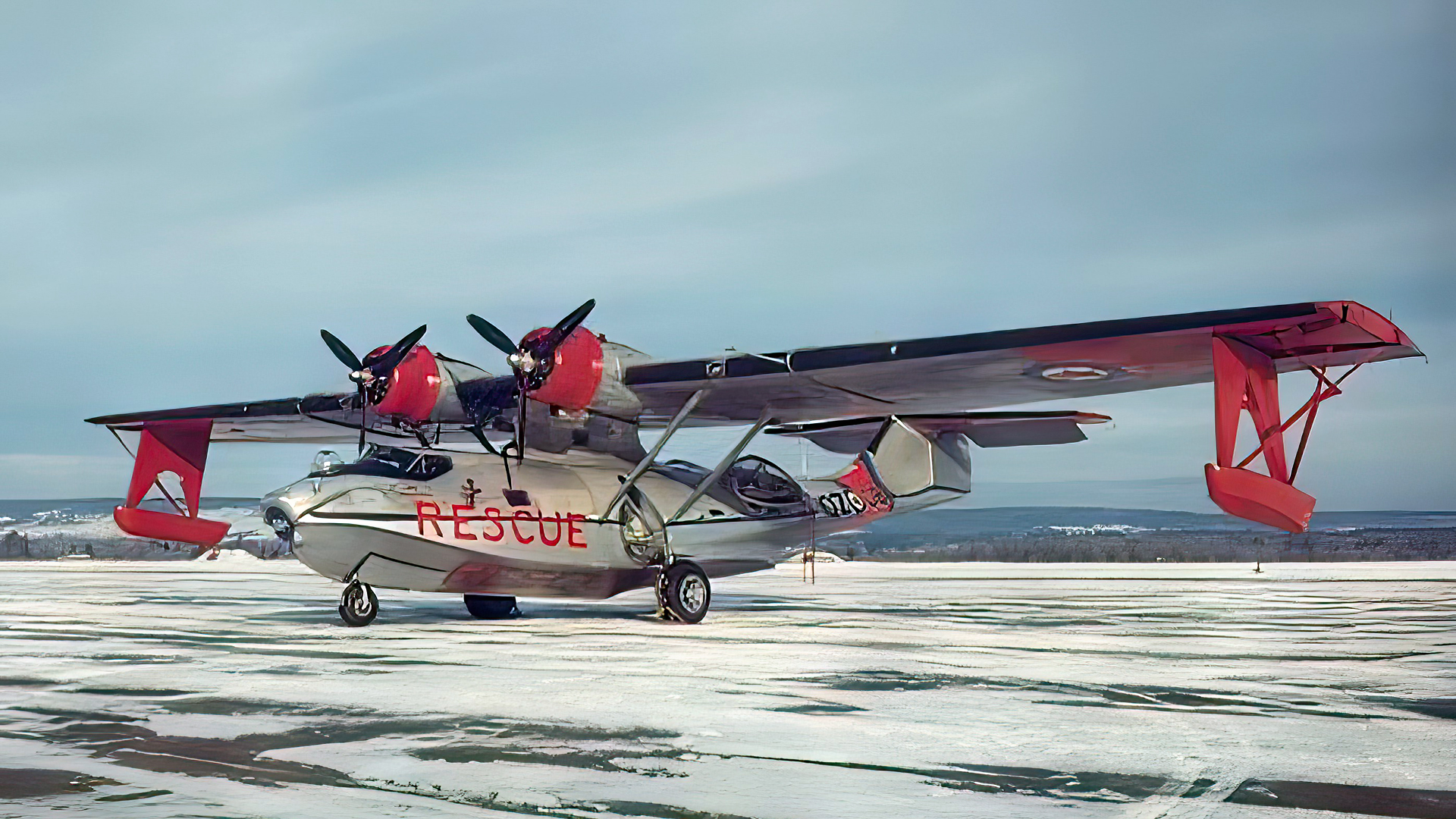 May 1942 and the first Canso assembled there rolled out in September 1943. In the interim, Vickers had received a DND order for a further 100 Cansos and another from the U.S. for 230 OA-10As, a further version of the PBY-5. As soon as the war ended in 1945, company president Benjamin W. Franklin switched gears to focus on modifying DC-3s and C-47s for civilian use. Between 1945 and 1949, the company converted more than 250 planes, selling them to fledgling operations such as Trans-Canada Airlines and Canadian Pacific Airlines.
May 1942 and the first Canso assembled there rolled out in September 1943. In the interim, Vickers had received a DND order for a further 100 Cansos and another from the U.S. for 230 OA-10As, a further version of the PBY-5. As soon as the war ended in 1945, company president Benjamin W. Franklin switched gears to focus on modifying DC-3s and C-47s for civilian use. Between 1945 and 1949, the company converted more than 250 planes, selling them to fledgling operations such as Trans-Canada Airlines and Canadian Pacific Airlines.
 aircraft). A few weeks later, the government asked Vickers to plan and supervise the construction of a new production facility in the Montreal area which, when completed, Vickers would manage on the government’s behalf. The site chosen was Cartierville Airport in suburban Ville St. Laurent. Because space at Vickers’ Montreal shipyard was limited, the first 25 Cansos were assembled at St. Hubert airport, across the St. Lawrence River from Montreal. Work on the Cartierville plant began in
aircraft). A few weeks later, the government asked Vickers to plan and supervise the construction of a new production facility in the Montreal area which, when completed, Vickers would manage on the government’s behalf. The site chosen was Cartierville Airport in suburban Ville St. Laurent. Because space at Vickers’ Montreal shipyard was limited, the first 25 Cansos were assembled at St. Hubert airport, across the St. Lawrence River from Montreal. Work on the Cartierville plant began in
 May 1942 and the first Canso assembled there rolled out in September 1943. In the interim, Vickers had received a DND order for a further 100 Cansos and another from the U.S. for 230 OA-10As, a further version of the PBY-5. As soon as the war ended in 1945, company president Benjamin W. Franklin switched gears to focus on modifying DC-3s and C-47s for civilian use. Between 1945 and 1949, the company converted more than 250 planes, selling them to fledgling operations such as Trans-Canada Airlines and Canadian Pacific Airlines.
May 1942 and the first Canso assembled there rolled out in September 1943. In the interim, Vickers had received a DND order for a further 100 Cansos and another from the U.S. for 230 OA-10As, a further version of the PBY-5. As soon as the war ended in 1945, company president Benjamin W. Franklin switched gears to focus on modifying DC-3s and C-47s for civilian use. Between 1945 and 1949, the company converted more than 250 planes, selling them to fledgling operations such as Trans-Canada Airlines and Canadian Pacific Airlines.1946 - Canadair produced seventy-one Northstars, a conversion of the U.S.-designed DC-4 transport
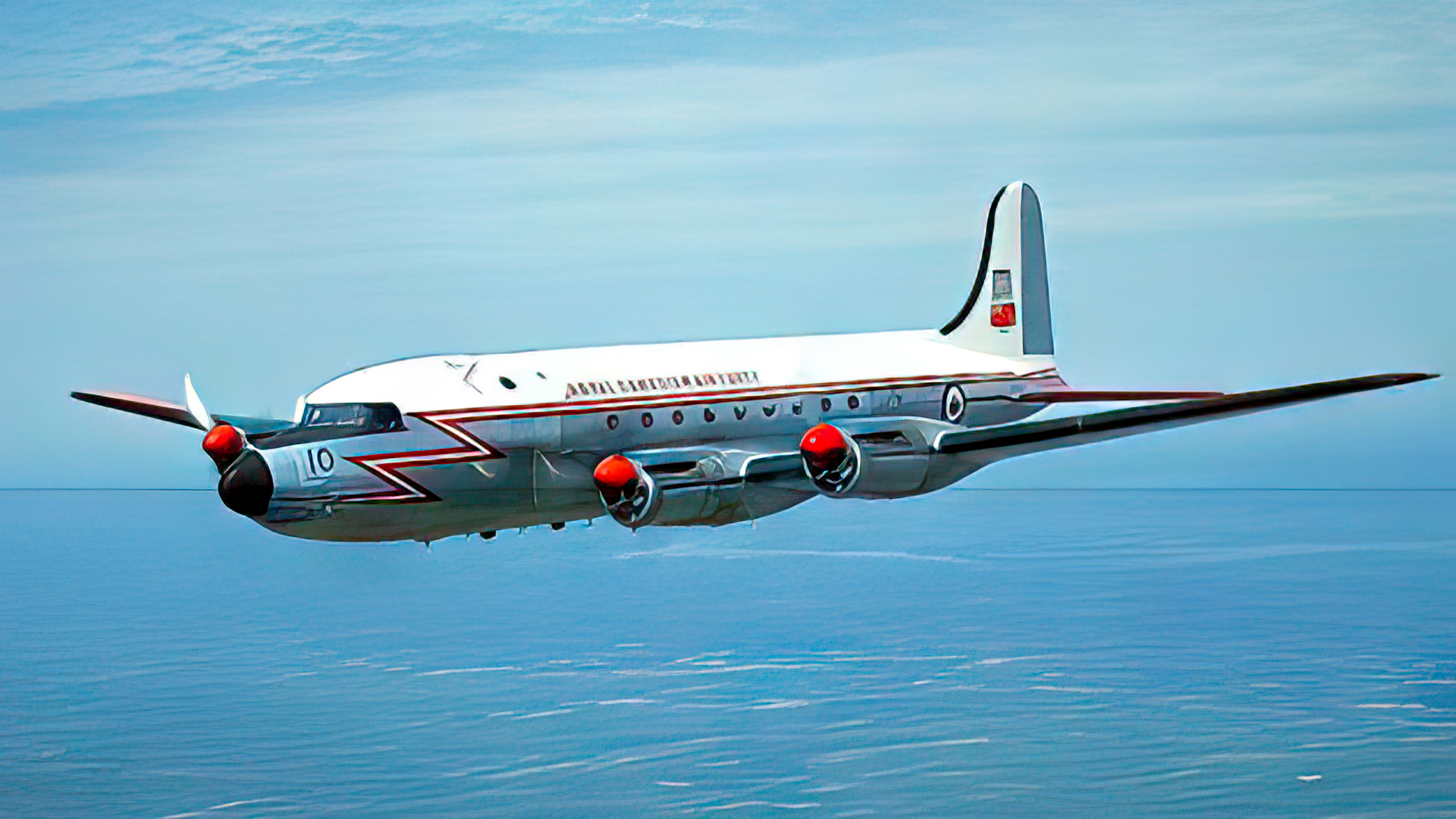 re-engined with Rolls Royce Merlin liquid cooled V16s. Apparently a successful but noisy conversion. Trans-Canada Airlines (later to become Air Canada) served as an early customer the Canadian-built Northstar airliner which both TCA and BOAC used on transatlantic flights.
re-engined with Rolls Royce Merlin liquid cooled V16s. Apparently a successful but noisy conversion. Trans-Canada Airlines (later to become Air Canada) served as an early customer the Canadian-built Northstar airliner which both TCA and BOAC used on transatlantic flights.
1950 - The North American F-86 Sabre was first flown on 01 October 1947 and the aircraft quickly
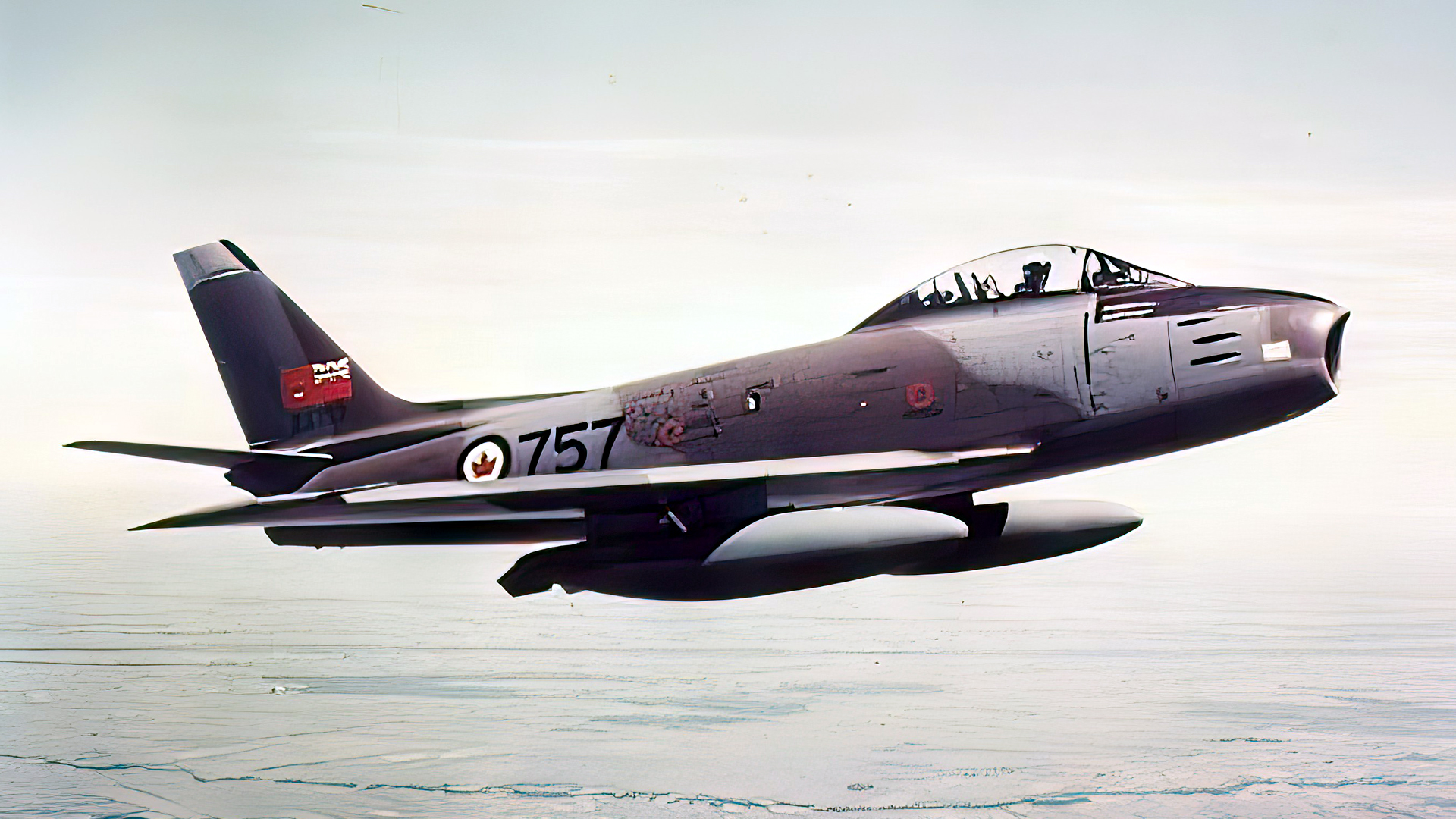 proved to be a highly successful design. In 1949, with the formation of NATO the Canadian government made the decision to re-equip the RCAF’s front-line fighter squadrons with modern aircraft and the F-86 Sabre was type selected. The Canadair Sabre Mk II was built by Canadair’s Cartierville Plant, with a total of 350 machines being built. Most of those aircraft were built for the RCAF, although 60 of these aircraft were diverted to the United States to help make up a shortage of Sabres due to the Korean War. A further three were sent to the RAF for evaluation.
proved to be a highly successful design. In 1949, with the formation of NATO the Canadian government made the decision to re-equip the RCAF’s front-line fighter squadrons with modern aircraft and the F-86 Sabre was type selected. The Canadair Sabre Mk II was built by Canadair’s Cartierville Plant, with a total of 350 machines being built. Most of those aircraft were built for the RCAF, although 60 of these aircraft were diverted to the United States to help make up a shortage of Sabres due to the Korean War. A further three were sent to the RAF for evaluation.
 proved to be a highly successful design. In 1949, with the formation of NATO the Canadian government made the decision to re-equip the RCAF’s front-line fighter squadrons with modern aircraft and the F-86 Sabre was type selected. The Canadair Sabre Mk II was built by Canadair’s Cartierville Plant, with a total of 350 machines being built. Most of those aircraft were built for the RCAF, although 60 of these aircraft were diverted to the United States to help make up a shortage of Sabres due to the Korean War. A further three were sent to the RAF for evaluation.
proved to be a highly successful design. In 1949, with the formation of NATO the Canadian government made the decision to re-equip the RCAF’s front-line fighter squadrons with modern aircraft and the F-86 Sabre was type selected. The Canadair Sabre Mk II was built by Canadair’s Cartierville Plant, with a total of 350 machines being built. Most of those aircraft were built for the RCAF, although 60 of these aircraft were diverted to the United States to help make up a shortage of Sabres due to the Korean War. A further three were sent to the RAF for evaluation.
1952 - The T-33 is an American designed plane which was developed by Lockheed. It evolved from one of the earliest jet aircraft, the single seat F-80 “Shooting Star” which first flew in
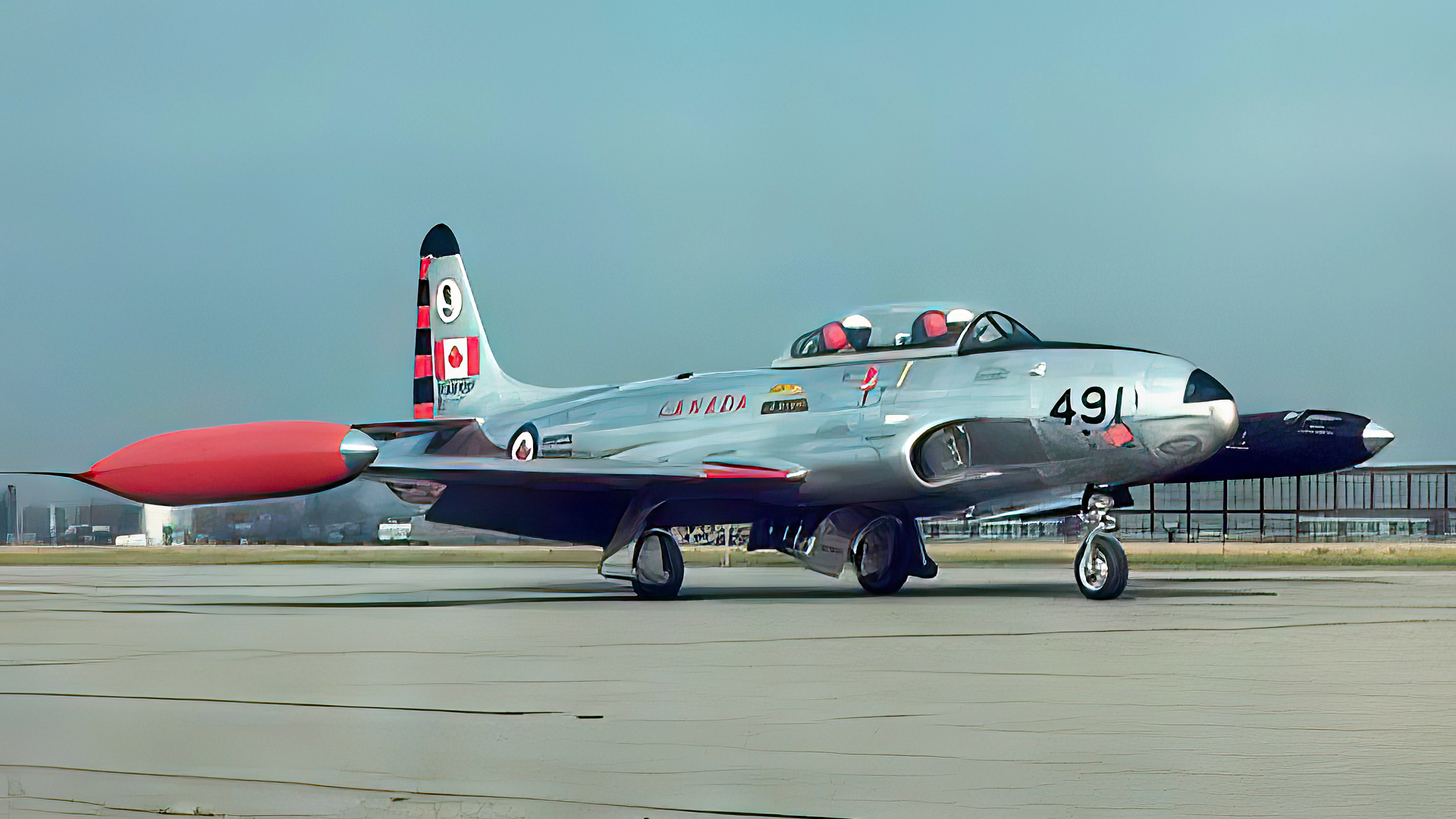 January of 1944 and was the first American jet combat aircraft to see general operational use. The prototype T-33 first flew in 1948. Carrying a crew of two in tandem, it was designed for armament training or to train pilots. For armament training, the T-33 could be fitted with two .50 Browning machine guns in the nose with under-wing stores including rockets or bombs. For many years the T-33 was the most widely flown jet trainer in the world, having been used by twenty-five countries. The Royal Canadian Air Force ordered twenty T-33s from Lockheed in 1951. Canadair then began building the aircraft and the Canadian prototype first flew in 1952. By the completion of the program in 1956, 656 aircraft had been assembled in Canada. The Canadian built T-33 were powered by a Nene engine which allowed them to outperform the Allison powered Lockheed Aircraft.
January of 1944 and was the first American jet combat aircraft to see general operational use. The prototype T-33 first flew in 1948. Carrying a crew of two in tandem, it was designed for armament training or to train pilots. For armament training, the T-33 could be fitted with two .50 Browning machine guns in the nose with under-wing stores including rockets or bombs. For many years the T-33 was the most widely flown jet trainer in the world, having been used by twenty-five countries. The Royal Canadian Air Force ordered twenty T-33s from Lockheed in 1951. Canadair then began building the aircraft and the Canadian prototype first flew in 1952. By the completion of the program in 1956, 656 aircraft had been assembled in Canada. The Canadian built T-33 were powered by a Nene engine which allowed them to outperform the Allison powered Lockheed Aircraft.
 January of 1944 and was the first American jet combat aircraft to see general operational use. The prototype T-33 first flew in 1948. Carrying a crew of two in tandem, it was designed for armament training or to train pilots. For armament training, the T-33 could be fitted with two .50 Browning machine guns in the nose with under-wing stores including rockets or bombs. For many years the T-33 was the most widely flown jet trainer in the world, having been used by twenty-five countries. The Royal Canadian Air Force ordered twenty T-33s from Lockheed in 1951. Canadair then began building the aircraft and the Canadian prototype first flew in 1952. By the completion of the program in 1956, 656 aircraft had been assembled in Canada. The Canadian built T-33 were powered by a Nene engine which allowed them to outperform the Allison powered Lockheed Aircraft.
January of 1944 and was the first American jet combat aircraft to see general operational use. The prototype T-33 first flew in 1948. Carrying a crew of two in tandem, it was designed for armament training or to train pilots. For armament training, the T-33 could be fitted with two .50 Browning machine guns in the nose with under-wing stores including rockets or bombs. For many years the T-33 was the most widely flown jet trainer in the world, having been used by twenty-five countries. The Royal Canadian Air Force ordered twenty T-33s from Lockheed in 1951. Canadair then began building the aircraft and the Canadian prototype first flew in 1952. By the completion of the program in 1956, 656 aircraft had been assembled in Canada. The Canadian built T-33 were powered by a Nene engine which allowed them to outperform the Allison powered Lockheed Aircraft.
1957 - In 1954, beginning with a request by the Royal Canadian Air Force (RCAF)for a long range
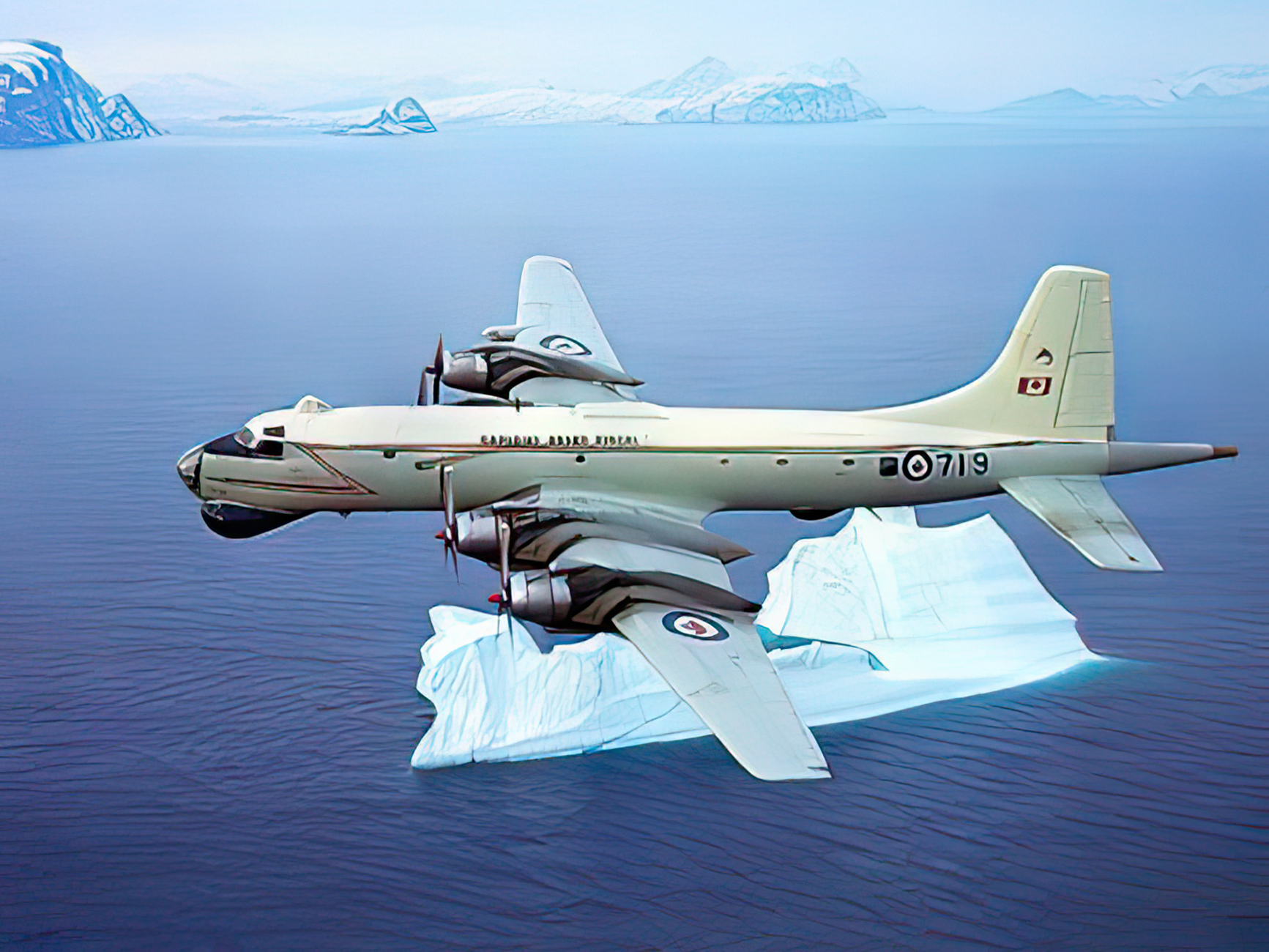 maritime patrol aircraft that could also be used as a transport, Canadair took on the task of turning Bristol Britannias into what would be known as the CL-28 Argus or the CC-106 Yukon (the CL-44-6 Yukon was the RCAF's transport version). The Canadian-built Canadair Argus was a unique hybrid that employed the wings, tail surfaces and undercarriage of the British designed Britannia turboprop transport, married to a completely new unpressurized fuselage of Canadian design and equipped with different American-designed engines. Piston engines were installed in place of Britannia's turboprops to improve endurance at low altitudes. The Argus replaced the Lancaster and Neptune aircraft types previously flown in the maritime roles and eventually, the Argus was itself to be replaced by the current CP-140 Aurora aircraft. Test pilot WS Longhurst and crew made the first test flight of the Argus prototype in 1957 from Cartierville airport.
maritime patrol aircraft that could also be used as a transport, Canadair took on the task of turning Bristol Britannias into what would be known as the CL-28 Argus or the CC-106 Yukon (the CL-44-6 Yukon was the RCAF's transport version). The Canadian-built Canadair Argus was a unique hybrid that employed the wings, tail surfaces and undercarriage of the British designed Britannia turboprop transport, married to a completely new unpressurized fuselage of Canadian design and equipped with different American-designed engines. Piston engines were installed in place of Britannia's turboprops to improve endurance at low altitudes. The Argus replaced the Lancaster and Neptune aircraft types previously flown in the maritime roles and eventually, the Argus was itself to be replaced by the current CP-140 Aurora aircraft. Test pilot WS Longhurst and crew made the first test flight of the Argus prototype in 1957 from Cartierville airport.
 maritime patrol aircraft that could also be used as a transport, Canadair took on the task of turning Bristol Britannias into what would be known as the CL-28 Argus or the CC-106 Yukon (the CL-44-6 Yukon was the RCAF's transport version). The Canadian-built Canadair Argus was a unique hybrid that employed the wings, tail surfaces and undercarriage of the British designed Britannia turboprop transport, married to a completely new unpressurized fuselage of Canadian design and equipped with different American-designed engines. Piston engines were installed in place of Britannia's turboprops to improve endurance at low altitudes. The Argus replaced the Lancaster and Neptune aircraft types previously flown in the maritime roles and eventually, the Argus was itself to be replaced by the current CP-140 Aurora aircraft. Test pilot WS Longhurst and crew made the first test flight of the Argus prototype in 1957 from Cartierville airport.
maritime patrol aircraft that could also be used as a transport, Canadair took on the task of turning Bristol Britannias into what would be known as the CL-28 Argus or the CC-106 Yukon (the CL-44-6 Yukon was the RCAF's transport version). The Canadian-built Canadair Argus was a unique hybrid that employed the wings, tail surfaces and undercarriage of the British designed Britannia turboprop transport, married to a completely new unpressurized fuselage of Canadian design and equipped with different American-designed engines. Piston engines were installed in place of Britannia's turboprops to improve endurance at low altitudes. The Argus replaced the Lancaster and Neptune aircraft types previously flown in the maritime roles and eventually, the Argus was itself to be replaced by the current CP-140 Aurora aircraft. Test pilot WS Longhurst and crew made the first test flight of the Argus prototype in 1957 from Cartierville airport.
The Argus was powered by four R-3350 Wright Cyclone radial enginess. The Cyclone engine was first tested in May, 1937 and versions of the engine remained in production well into 1950's. The R-3350 also found use in both civilian and military applications where it powered such aircraft as the Boeing B-29 Superfortress, Canadair CP-107 Argus, Fairchild C-119 Flying Boxcar, Douglas A-1 Skyraider and the Lockheed Constellation.
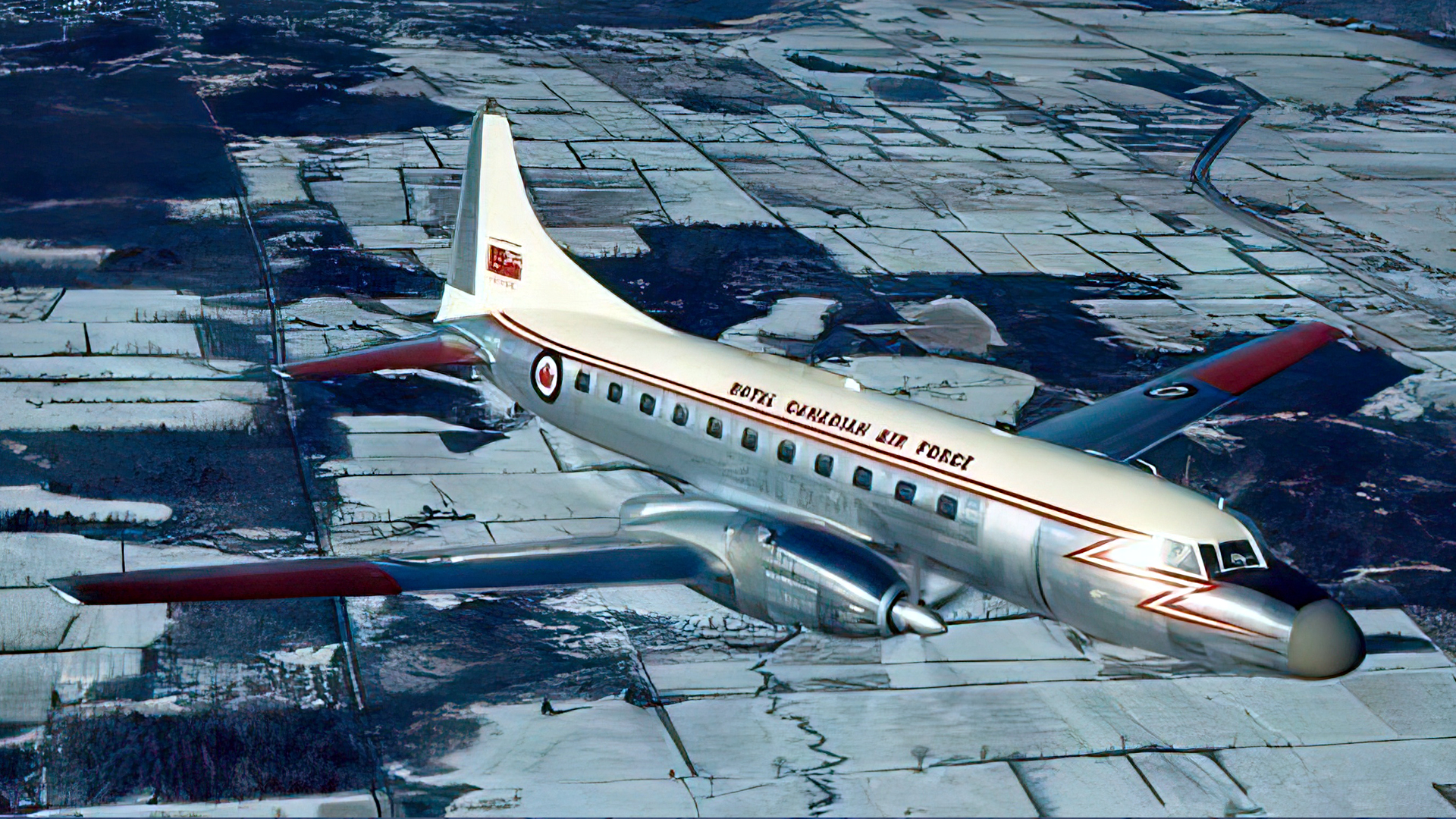 1959 - The Canadair CL-66 Cosmopolitan was a license-built version of the Convair 440, powered by Napier Eland turboprop engines. The aircraft were introduced in RCAF Air Transport Command and and were assigned to 412 Squadron at CFB Uplands (Ottawa) where they were used as the RCAF’s primary medium range transport. The Cosmopolitan was also a VIP transport, one of which was attached to No. 101 Transport Flight at CFB Shearwater in the 1960’s. Single aircraft Cosmopolitan detachments also provided transport for the RCAF NATO Wings in Europe and for RCAF/Canadian Forces personnel at NORAD Headquarters in Colorado Springs. The aircraft was retired from RCAF service in June 1994.
1959 - The Canadair CL-66 Cosmopolitan was a license-built version of the Convair 440, powered by Napier Eland turboprop engines. The aircraft were introduced in RCAF Air Transport Command and and were assigned to 412 Squadron at CFB Uplands (Ottawa) where they were used as the RCAF’s primary medium range transport. The Cosmopolitan was also a VIP transport, one of which was attached to No. 101 Transport Flight at CFB Shearwater in the 1960’s. Single aircraft Cosmopolitan detachments also provided transport for the RCAF NATO Wings in Europe and for RCAF/Canadian Forces personnel at NORAD Headquarters in Colorado Springs. The aircraft was retired from RCAF service in June 1994.
1959 - The Canadair CL-44 was a freight transport development of the British
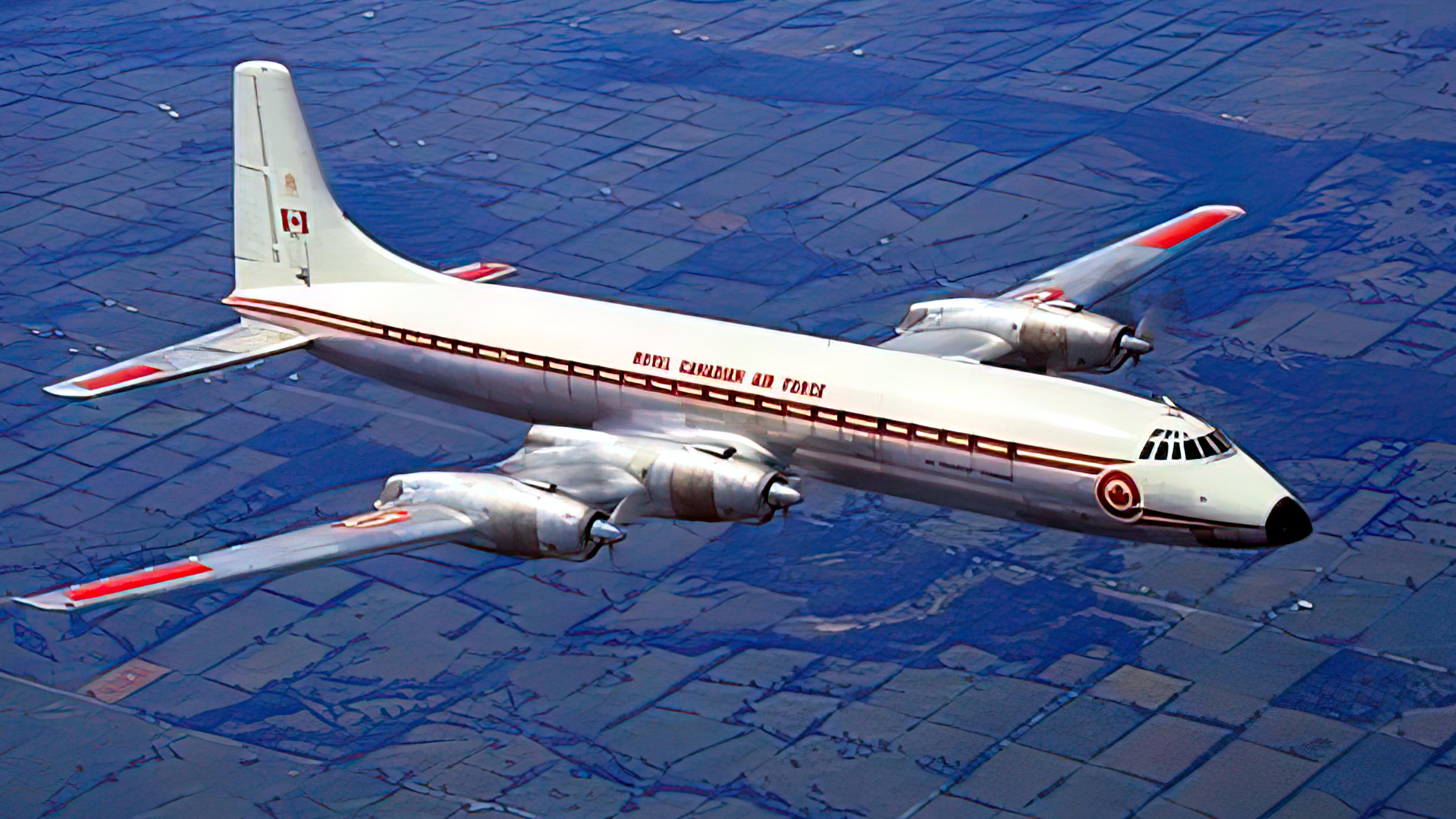 built Bristol Brittania (apparently called the "Whispering Giant"). which made its maiden flight on November 15, 1959. It was larger and powered by Rolls-Royce Tyne engines. Twelve were ordered by the RCAF, and were given the name CC-106 Yukon. Later models were marketed as the Canadair CL "Forty Four" and featured a folding aft fuselages, or swingtail, to facilitate loading/unloading of bulky items. Iceland's major air carrier Lofleider was a customer and the CL was its prime freighter for many years.
built Bristol Brittania (apparently called the "Whispering Giant"). which made its maiden flight on November 15, 1959. It was larger and powered by Rolls-Royce Tyne engines. Twelve were ordered by the RCAF, and were given the name CC-106 Yukon. Later models were marketed as the Canadair CL "Forty Four" and featured a folding aft fuselages, or swingtail, to facilitate loading/unloading of bulky items. Iceland's major air carrier Lofleider was a customer and the CL was its prime freighter for many years.
Information from Ron Hay: Equal to the aging Lancaster's the RCAF was looking for replacements for it's C-54GM North Star. The new planes were primarily intended to provide personnel and logistics support for Canadian Forces in Europe. Since Canadair had already acquired a licence for the Bristol Britannia, Ottawa announced in January 1957 plans for a fleet of long range transports based on the Britannia. Canadair received a contract for 8 aircraft, later increased to 12. Canadair designation CL-44-6 and CC-106 by the RCAF.
The design used the modified Argus wings and controls. The fuselage was almost identical to the Britannia 300 with two Cargo doors on the left-hand side. The cabin was pressurized to maintain a cabin altitude of 8,000 ft. at 30,000 ft. The Yukon could accommodate 134 passengers and a crew of nine. In the casualty evacuation role it could take 80 patients and a crew of 11. The RCAF had specified the CL-44 to be equipped with Bristol Orion engines. When the British ministry of Supply dropped the Bristol Orion the RCAF decided to use the Rolls Royce Tyne 11. The roll out of the Yukon was a disaster all over. When the prototype was supposed to be pushed out of the hangar, the tail was too high. The first plane took off 15 November 1959. During test flights all kind of problems where encountered from complete electrical failure to engines shaking loose and almost falling off. Rolls Royce had problems delivering engines resulting in "Yukon gliders" being parked outside Canadair as late as 1961.
The CL-446 military transport version (RCAF designation CC-l06) had a pressurized fuselage with conventional side-loading of freight through double doors in the port side. Capable of carrying a 27433-kg (60480 lb) payload, the first Yukon was completed in August 1959 and made its initial flight three months later, on November 15. The powerplant comprised four Rolls-Royce Tyne Mk 515/10 engines, making it Canada's first turboprop-powered aircraft to attain production status. Range with maximum payload was 3800 km (2360 miles); with maximum fuel and reduced payload, this could be extended to 9090 km (5650 miles). The cruising speed of the CC-106 was 370 mph.
Twelve Yukons were built, two being allocated to No 412 Squadron of the Royal Canadian Air Force (with convertible interiors for use as passenger and VIP transports), and ten to No 437 Squadron for long-range logistic support of Canadian forces in Europe (No 1 Air Division), Africa and the Middle East. Designed for high-speed, long-range transport duty, the pressurized Yukon could haul a 27-ton payload some 2,000 miles and a 14-ton payload nearly 4,000 miles. On the regular, scheduled trans-Atlantic trooping runs which the Yukons had been flying since January of 1962, the aircraft was arranged to accommodate 134 passengers and carried a crew of ten. Operated by 412 and 437 Squadrons, the Yukon provided a ten-hour, non-stop trans-Atlantic service from Ottawa or Trenton to Marville, France. It was a Yukon of 437 Squadron which, in December of 1961, set a Canadian record for long-distance flight by making the 6,750 mile non-stop trip from Tokyo to Trenton in 17 hours and 3 minutes, at an average speed of almost 640 km/h (400 mph). In July 1962 a Yukon set a new record by staying airborne for 23 hours and 51 minutes. These records stayed untouched until broken by the new 747SP in 1975. Ten Yukon's flew for 437 Transport Squadron. Two flew as VIP transports for 412 Squadron.
The RCAF retired its Yukon's in March 1971 - selling 12 aircraft and spares for $1.1 million Canadian. It was time to upgrade the fleet with Boeing 707's. The Yukons might have served longer with the RCAF but for two factors. First, the RCAF needed an aircraft which could operate as an in-flight refueling tanker and second, the chronic shortage of spares. The latter problems resulted from the fact that the CL-44 had never gone into large-scale production. Consequently spare parts tended to be in short supply and relatively expensive. The Yukon flew 65 million miles, 1.5 billion passenger miles and 360 million ton-miles. All Yukon's were sold to South American and African operators since it could not be registered in Northern America or Europe since the Britannia windshields did not meet new security standards.
 built Bristol Brittania (apparently called the "Whispering Giant"). which made its maiden flight on November 15, 1959. It was larger and powered by Rolls-Royce Tyne engines. Twelve were ordered by the RCAF, and were given the name CC-106 Yukon. Later models were marketed as the Canadair CL "Forty Four" and featured a folding aft fuselages, or swingtail, to facilitate loading/unloading of bulky items. Iceland's major air carrier Lofleider was a customer and the CL was its prime freighter for many years.
built Bristol Brittania (apparently called the "Whispering Giant"). which made its maiden flight on November 15, 1959. It was larger and powered by Rolls-Royce Tyne engines. Twelve were ordered by the RCAF, and were given the name CC-106 Yukon. Later models were marketed as the Canadair CL "Forty Four" and featured a folding aft fuselages, or swingtail, to facilitate loading/unloading of bulky items. Iceland's major air carrier Lofleider was a customer and the CL was its prime freighter for many years.Information from Ron Hay: Equal to the aging Lancaster's the RCAF was looking for replacements for it's C-54GM North Star. The new planes were primarily intended to provide personnel and logistics support for Canadian Forces in Europe. Since Canadair had already acquired a licence for the Bristol Britannia, Ottawa announced in January 1957 plans for a fleet of long range transports based on the Britannia. Canadair received a contract for 8 aircraft, later increased to 12. Canadair designation CL-44-6 and CC-106 by the RCAF.
The design used the modified Argus wings and controls. The fuselage was almost identical to the Britannia 300 with two Cargo doors on the left-hand side. The cabin was pressurized to maintain a cabin altitude of 8,000 ft. at 30,000 ft. The Yukon could accommodate 134 passengers and a crew of nine. In the casualty evacuation role it could take 80 patients and a crew of 11. The RCAF had specified the CL-44 to be equipped with Bristol Orion engines. When the British ministry of Supply dropped the Bristol Orion the RCAF decided to use the Rolls Royce Tyne 11. The roll out of the Yukon was a disaster all over. When the prototype was supposed to be pushed out of the hangar, the tail was too high. The first plane took off 15 November 1959. During test flights all kind of problems where encountered from complete electrical failure to engines shaking loose and almost falling off. Rolls Royce had problems delivering engines resulting in "Yukon gliders" being parked outside Canadair as late as 1961.
The CL-446 military transport version (RCAF designation CC-l06) had a pressurized fuselage with conventional side-loading of freight through double doors in the port side. Capable of carrying a 27433-kg (60480 lb) payload, the first Yukon was completed in August 1959 and made its initial flight three months later, on November 15. The powerplant comprised four Rolls-Royce Tyne Mk 515/10 engines, making it Canada's first turboprop-powered aircraft to attain production status. Range with maximum payload was 3800 km (2360 miles); with maximum fuel and reduced payload, this could be extended to 9090 km (5650 miles). The cruising speed of the CC-106 was 370 mph.
Twelve Yukons were built, two being allocated to No 412 Squadron of the Royal Canadian Air Force (with convertible interiors for use as passenger and VIP transports), and ten to No 437 Squadron for long-range logistic support of Canadian forces in Europe (No 1 Air Division), Africa and the Middle East. Designed for high-speed, long-range transport duty, the pressurized Yukon could haul a 27-ton payload some 2,000 miles and a 14-ton payload nearly 4,000 miles. On the regular, scheduled trans-Atlantic trooping runs which the Yukons had been flying since January of 1962, the aircraft was arranged to accommodate 134 passengers and carried a crew of ten. Operated by 412 and 437 Squadrons, the Yukon provided a ten-hour, non-stop trans-Atlantic service from Ottawa or Trenton to Marville, France. It was a Yukon of 437 Squadron which, in December of 1961, set a Canadian record for long-distance flight by making the 6,750 mile non-stop trip from Tokyo to Trenton in 17 hours and 3 minutes, at an average speed of almost 640 km/h (400 mph). In July 1962 a Yukon set a new record by staying airborne for 23 hours and 51 minutes. These records stayed untouched until broken by the new 747SP in 1975. Ten Yukon's flew for 437 Transport Squadron. Two flew as VIP transports for 412 Squadron.
The RCAF retired its Yukon's in March 1971 - selling 12 aircraft and spares for $1.1 million Canadian. It was time to upgrade the fleet with Boeing 707's. The Yukons might have served longer with the RCAF but for two factors. First, the RCAF needed an aircraft which could operate as an in-flight refueling tanker and second, the chronic shortage of spares. The latter problems resulted from the fact that the CL-44 had never gone into large-scale production. Consequently spare parts tended to be in short supply and relatively expensive. The Yukon flew 65 million miles, 1.5 billion passenger miles and 360 million ton-miles. All Yukon's were sold to South American and African operators since it could not be registered in Northern America or Europe since the Britannia windshields did not meet new security standards.
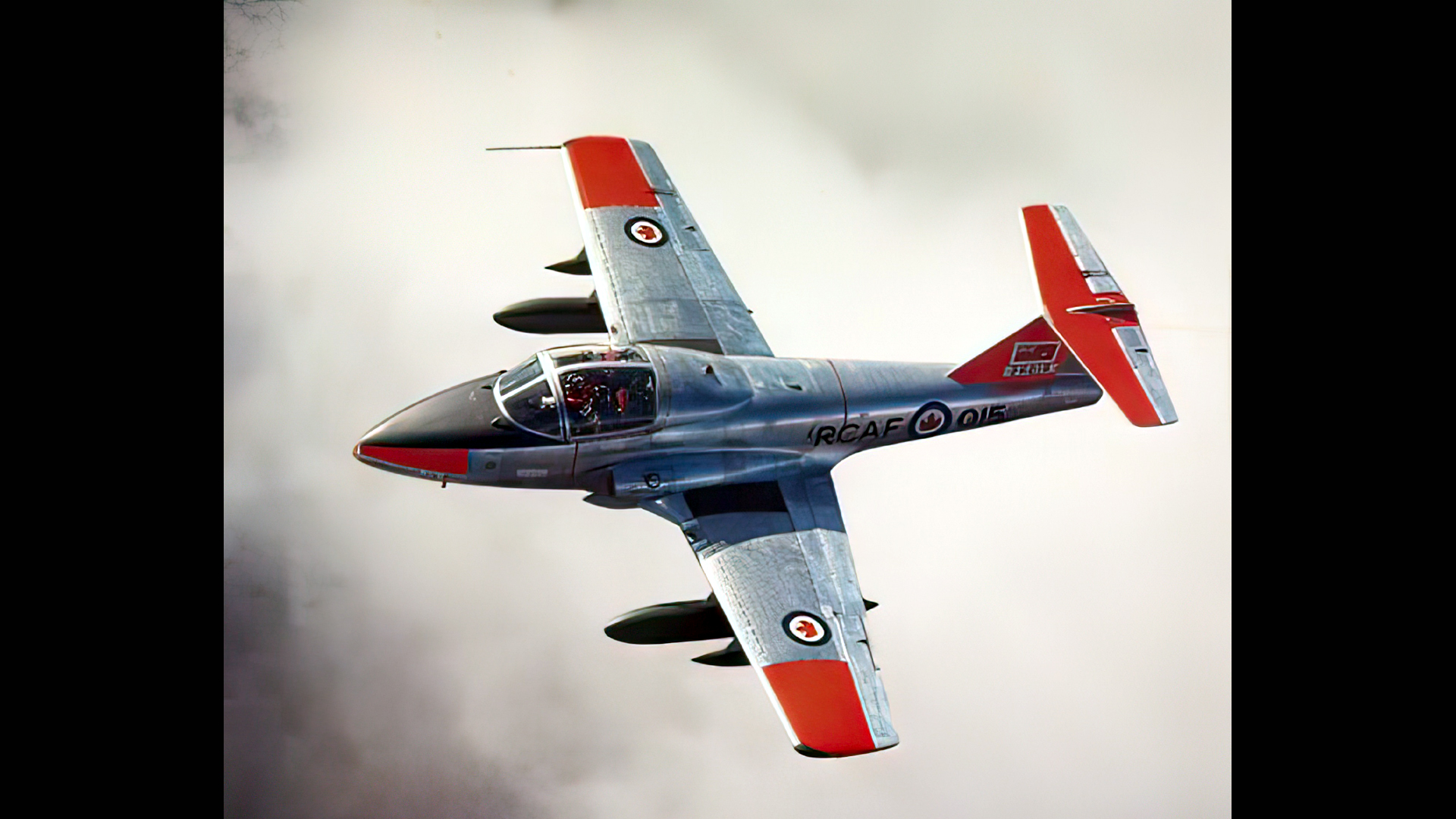 1960 - The CL-41 Tutor is jet trainer with side-by-side seating. The first prototype flew on January 13, 1960. 190 aircraft were built for Canadian air forces and 20 CL-41G for Malaysia. There was also CL-41R modification with "Starfighter"-like nose.
1960 - The CL-41 Tutor is jet trainer with side-by-side seating. The first prototype flew on January 13, 1960. 190 aircraft were built for Canadian air forces and 20 CL-41G for Malaysia. There was also CL-41R modification with "Starfighter"-like nose.
1961 - The first production Lockheed CF-104 Starfighter, built under license by Canadair was built
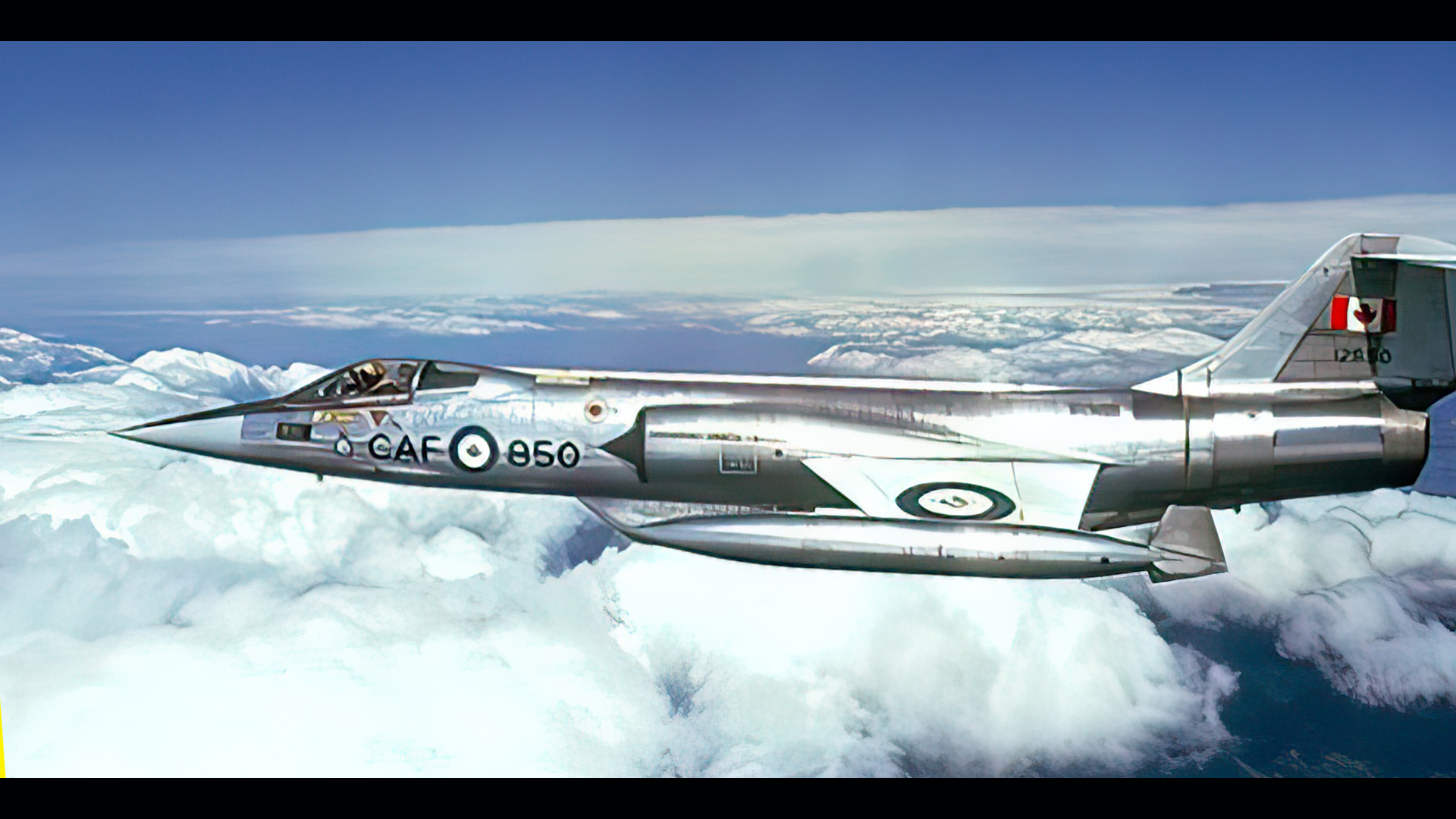 on March 18, 1961. The first flight of a Canadair CF-104 occurred on August 14, 1961. 238 were built for the RCAF. Canadair built an additional 150 Starfighters for other NATO Nations.
on March 18, 1961. The first flight of a Canadair CF-104 occurred on August 14, 1961. 238 were built for the RCAF. Canadair built an additional 150 Starfighters for other NATO Nations.
 on March 18, 1961. The first flight of a Canadair CF-104 occurred on August 14, 1961. 238 were built for the RCAF. Canadair built an additional 150 Starfighters for other NATO Nations.
on March 18, 1961. The first flight of a Canadair CF-104 occurred on August 14, 1961. 238 were built for the RCAF. Canadair built an additional 150 Starfighters for other NATO Nations.
1965 - The CL-84 Dynavert was a joint Canada/USA VTOL (Vertical Take OFF and Landing) test aircraft. The Dynavert made its first vertical flight in May 1965 and The first total transition flight was accomplished
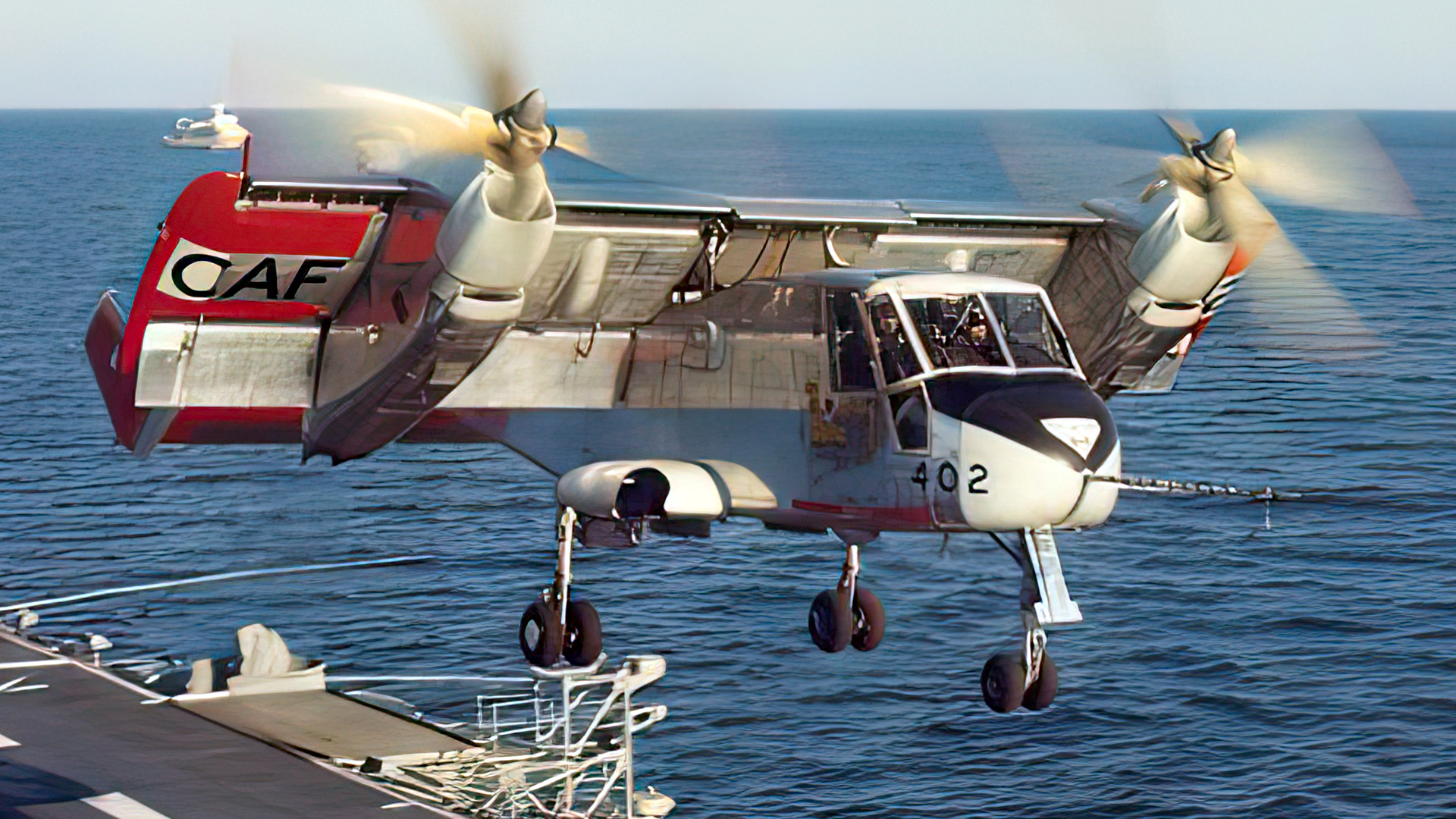 January 17, 1966. Transition was made from hover to forward flight and back. Flights were made in light snow with wind gusting to 25 miles per hour. The flight, with company pilot WS Longhurst at the controls, came seven months ahead of schedule. By April 1966, the CL-84 had completed 70 test flights consisting of hover, conventional flight, STOL, and transition flights. The first prototype was flown for two years by 16 pilots for a total of 145 flying hours. The design of the Canadian CL-84 was begun in November 1963. It weighed 8,100 lb empty, could make a vertical take-off at 12,200 lb, or a short take-off at 14,700 lb. The wings were 33 ft long and housed two 1,450 shp Lycoming T53-LTC1K-4A turboprops which powered the cross-linked 14 ft four-bladed propellers. Pitch control was provided by two counter-rotating two-bladed horizontal propellers, which in horizontal flight were stopped and aligned to minimize drag. Roll control was by differential pitch, and yaw was controlled with ailerons.
January 17, 1966. Transition was made from hover to forward flight and back. Flights were made in light snow with wind gusting to 25 miles per hour. The flight, with company pilot WS Longhurst at the controls, came seven months ahead of schedule. By April 1966, the CL-84 had completed 70 test flights consisting of hover, conventional flight, STOL, and transition flights. The first prototype was flown for two years by 16 pilots for a total of 145 flying hours. The design of the Canadian CL-84 was begun in November 1963. It weighed 8,100 lb empty, could make a vertical take-off at 12,200 lb, or a short take-off at 14,700 lb. The wings were 33 ft long and housed two 1,450 shp Lycoming T53-LTC1K-4A turboprops which powered the cross-linked 14 ft four-bladed propellers. Pitch control was provided by two counter-rotating two-bladed horizontal propellers, which in horizontal flight were stopped and aligned to minimize drag. Roll control was by differential pitch, and yaw was controlled with ailerons.
 January 17, 1966. Transition was made from hover to forward flight and back. Flights were made in light snow with wind gusting to 25 miles per hour. The flight, with company pilot WS Longhurst at the controls, came seven months ahead of schedule. By April 1966, the CL-84 had completed 70 test flights consisting of hover, conventional flight, STOL, and transition flights. The first prototype was flown for two years by 16 pilots for a total of 145 flying hours. The design of the Canadian CL-84 was begun in November 1963. It weighed 8,100 lb empty, could make a vertical take-off at 12,200 lb, or a short take-off at 14,700 lb. The wings were 33 ft long and housed two 1,450 shp Lycoming T53-LTC1K-4A turboprops which powered the cross-linked 14 ft four-bladed propellers. Pitch control was provided by two counter-rotating two-bladed horizontal propellers, which in horizontal flight were stopped and aligned to minimize drag. Roll control was by differential pitch, and yaw was controlled with ailerons.
January 17, 1966. Transition was made from hover to forward flight and back. Flights were made in light snow with wind gusting to 25 miles per hour. The flight, with company pilot WS Longhurst at the controls, came seven months ahead of schedule. By April 1966, the CL-84 had completed 70 test flights consisting of hover, conventional flight, STOL, and transition flights. The first prototype was flown for two years by 16 pilots for a total of 145 flying hours. The design of the Canadian CL-84 was begun in November 1963. It weighed 8,100 lb empty, could make a vertical take-off at 12,200 lb, or a short take-off at 14,700 lb. The wings were 33 ft long and housed two 1,450 shp Lycoming T53-LTC1K-4A turboprops which powered the cross-linked 14 ft four-bladed propellers. Pitch control was provided by two counter-rotating two-bladed horizontal propellers, which in horizontal flight were stopped and aligned to minimize drag. Roll control was by differential pitch, and yaw was controlled with ailerons.
1967 - The Canadair CL-214 and CL-415 "SuperScooper" were were purpose-designed amphibians and were the only aircraft ever designed specifically as water bombers.
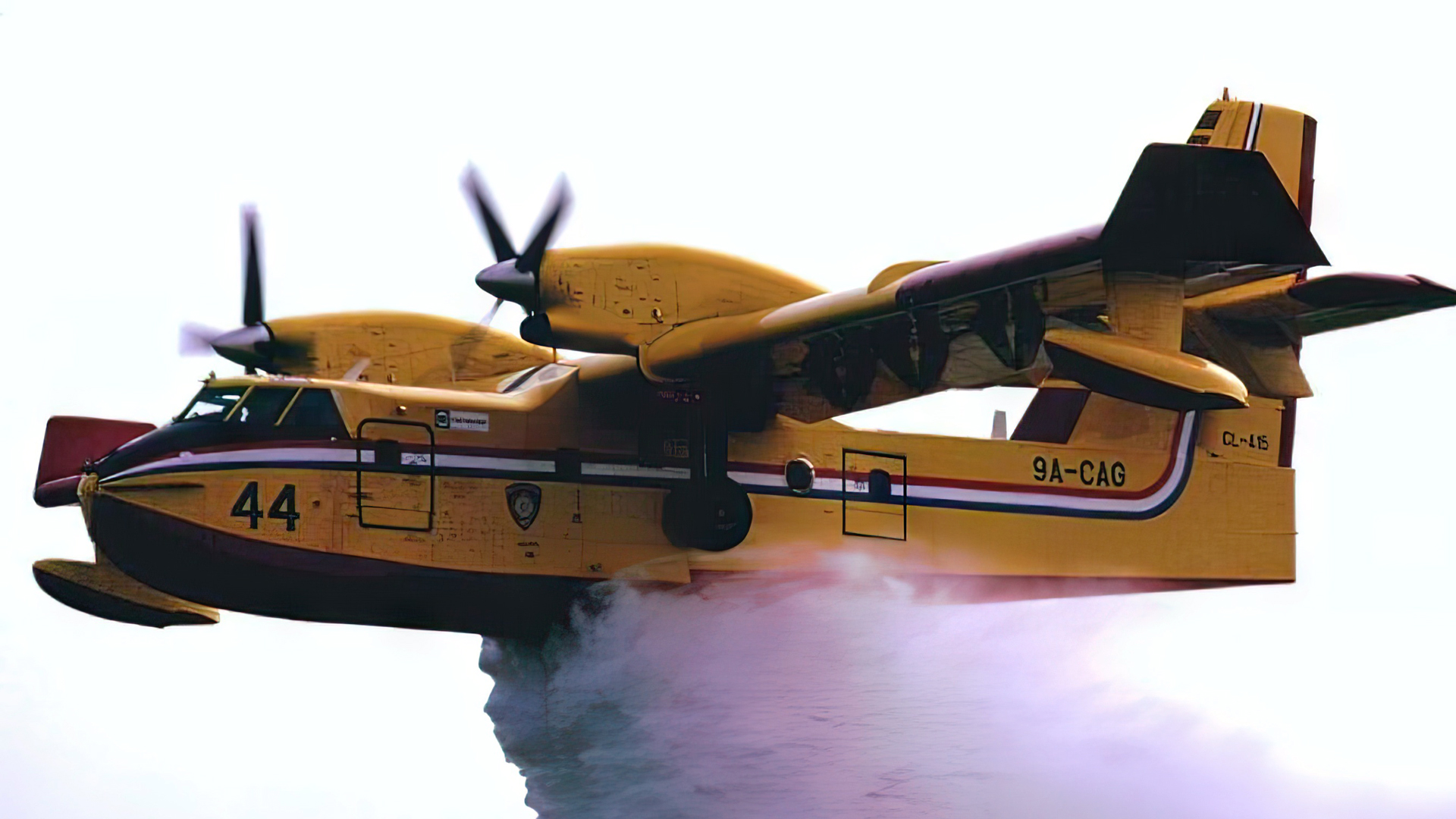 The CL-415 is a turbo-prop development of the radial engined CL-215 which first flew on 23 October 1967. The first CL-215 delivery was to France, with production continuing in batches through to 1990. In 1989 Canadair tested two CL-215s with turbo-prop engines. The CL-215T was not pursued, beyond offering retro-fit engines for existing CL-215 aircraft. The improved, turbo-prop CL-415 first flew in December 1993, with deliveries beginning in 1994. The aircraft remains primarily a fire-bomber, but can be configured for other purposes, including passenger, passenger/cargo, maritime patrol, or search and rescue.
The CL-415 is a turbo-prop development of the radial engined CL-215 which first flew on 23 October 1967. The first CL-215 delivery was to France, with production continuing in batches through to 1990. In 1989 Canadair tested two CL-215s with turbo-prop engines. The CL-215T was not pursued, beyond offering retro-fit engines for existing CL-215 aircraft. The improved, turbo-prop CL-415 first flew in December 1993, with deliveries beginning in 1994. The aircraft remains primarily a fire-bomber, but can be configured for other purposes, including passenger, passenger/cargo, maritime patrol, or search and rescue.
 The CL-415 is a turbo-prop development of the radial engined CL-215 which first flew on 23 October 1967. The first CL-215 delivery was to France, with production continuing in batches through to 1990. In 1989 Canadair tested two CL-215s with turbo-prop engines. The CL-215T was not pursued, beyond offering retro-fit engines for existing CL-215 aircraft. The improved, turbo-prop CL-415 first flew in December 1993, with deliveries beginning in 1994. The aircraft remains primarily a fire-bomber, but can be configured for other purposes, including passenger, passenger/cargo, maritime patrol, or search and rescue.
The CL-415 is a turbo-prop development of the radial engined CL-215 which first flew on 23 October 1967. The first CL-215 delivery was to France, with production continuing in batches through to 1990. In 1989 Canadair tested two CL-215s with turbo-prop engines. The CL-215T was not pursued, beyond offering retro-fit engines for existing CL-215 aircraft. The improved, turbo-prop CL-415 first flew in December 1993, with deliveries beginning in 1994. The aircraft remains primarily a fire-bomber, but can be configured for other purposes, including passenger, passenger/cargo, maritime patrol, or search and rescue.
1968 - The first Canadair-built CF-5A rolled off the line at Cartierville on February 6, 1968.
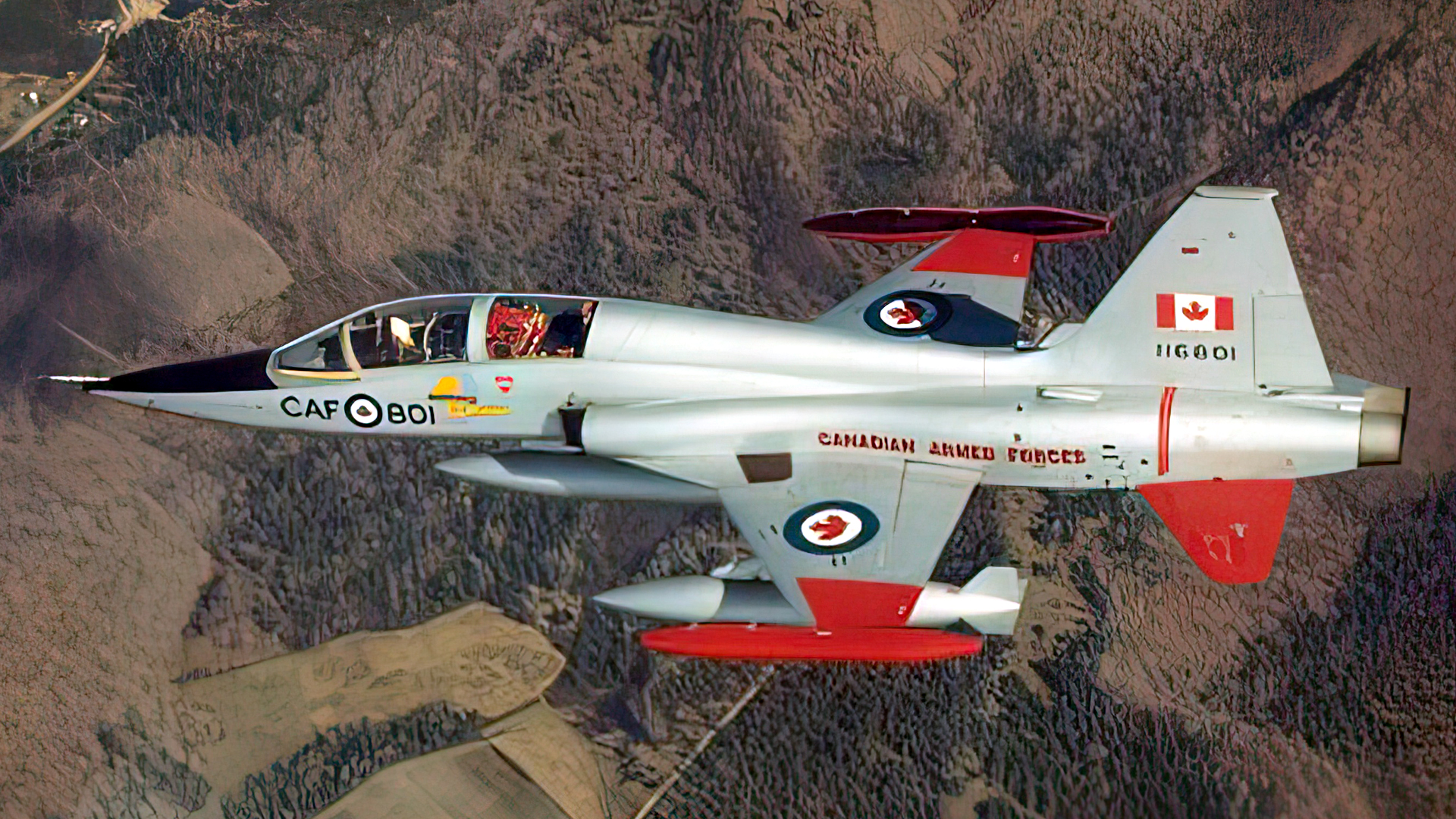 It made its maiden flight on May 6, 1968 from Edwards Air Force Base (California), piloted by Northrop test pilot Hank Chouteau. By that time, it had been reserialed 116701. 116701 crashed at Edwards on December 3, 1969. The second CF-5 aircraft was also flown to California for flight testing by Northrop.
It made its maiden flight on May 6, 1968 from Edwards Air Force Base (California), piloted by Northrop test pilot Hank Chouteau. By that time, it had been reserialed 116701. 116701 crashed at Edwards on December 3, 1969. The second CF-5 aircraft was also flown to California for flight testing by Northrop.
 It made its maiden flight on May 6, 1968 from Edwards Air Force Base (California), piloted by Northrop test pilot Hank Chouteau. By that time, it had been reserialed 116701. 116701 crashed at Edwards on December 3, 1969. The second CF-5 aircraft was also flown to California for flight testing by Northrop.
It made its maiden flight on May 6, 1968 from Edwards Air Force Base (California), piloted by Northrop test pilot Hank Chouteau. By that time, it had been reserialed 116701. 116701 crashed at Edwards on December 3, 1969. The second CF-5 aircraft was also flown to California for flight testing by Northrop.
Aerial Views of Cartierville Airport
Although Cartierville airport began operations in the 1920's, Dorval airport (4 miles to the Southwest)became Canada's busiest airport and during the 60's and early 70's, was the major Canadian airport connecting Canada to Europe. However as modern jet technology improved, non-stop air travel to Europe became available from Vancouver. Cartierville as well was not immune from future changes and in the early '70s Laurentide Aviation, a major flying training business at Cartierville, built a training airport at Cedars, Southwest of Montreal and the remaining VFR training operations moved to St. Hubert on the South shore. Canadair would be bought out by Bombardier and began life anew, manufacturing CL-215 water bombers and the very successful Challenger and RJ business/air carrier passenger jets. As final production was done at Dorval's factory, Cartierville's runway 28 was no longer needed and today condos cover the area and old timers would not recognize the area. Here are a collection of YCV photos from 1929 to 1998. I do apologize that I have lost last year's coding and I cannot give photo credits to many of the photos.
Left mouse click on the photos for a much larger image.
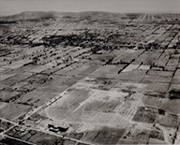
1929 - This photo is the earliest I have found. Amazing how Montreal has changed. I do believe that is St.Laurent Boulevard running North/South just to the East of the airport.
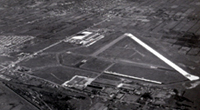
1946 - Now Cartierville has become a major aircraft manufacturing area. Notice the Cansos and DC-3s in front of where the DOT tower was located and again a line of bigger aircraft in front of the Vickers (later Canadair) factory on St.Laurent Blvd.
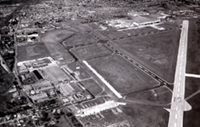
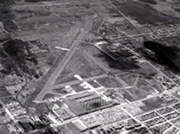
1959 on the left and 1961 on the right - That is Laurentide Aviation beside the Canadair factory and Wondel Aviation near the corner of St.Laurent Blvd and Bois Franc road. I'm not sure I can discern the Montreal Flying Club beside the tower.
Here are two aerial views of Cartierville. In the first you get an idea of just how close Dorval and Cartierville were. Easily identifiable in good VFR, but less so, MUCH LESS so, in marginal VFR, we used to joke that maybe Cartierville was Dorval's alternate...
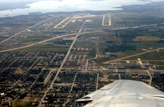 1973 - On the left an excellent view of Dorval and Cartierville airports. To add to the confusion both UYL YCV had runway 28s and 24s.
1973 - On the left an excellent view of Dorval and Cartierville airports. To add to the confusion both UYL YCV had runway 28s and 24s.

On the right another excellent 1973 view of Cartierville airport. It used to have a 3rd runway 15/33 which added complexity to an already busy environment. Thankfully that runway was closed in 1967. As I mentioned earlier, Rene Proulx loved 3 runway operations while I thought it was dicey.
1973 aerial photos courtesy of Denis Garand
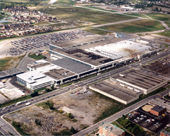
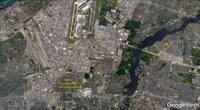 ( left ) 1998 - The transformation from a rural setting to a busy airport to an urban environment is now complete.
( left ) 1998 - The transformation from a rural setting to a busy airport to an urban environment is now complete.
(right) 2019 - Here is a Google Earth view from 2019, Cartierville airport is but a distant memory.
Back to Top

1929 - This photo is the earliest I have found. Amazing how Montreal has changed. I do believe that is St.Laurent Boulevard running North/South just to the East of the airport.

1946 - Now Cartierville has become a major aircraft manufacturing area. Notice the Cansos and DC-3s in front of where the DOT tower was located and again a line of bigger aircraft in front of the Vickers (later Canadair) factory on St.Laurent Blvd.


1959 on the left and 1961 on the right - That is Laurentide Aviation beside the Canadair factory and Wondel Aviation near the corner of St.Laurent Blvd and Bois Franc road. I'm not sure I can discern the Montreal Flying Club beside the tower.
Here are two aerial views of Cartierville. In the first you get an idea of just how close Dorval and Cartierville were. Easily identifiable in good VFR, but less so, MUCH LESS so, in marginal VFR, we used to joke that maybe Cartierville was Dorval's alternate...
 1973 - On the left an excellent view of Dorval and Cartierville airports. To add to the confusion both UYL YCV had runway 28s and 24s.
1973 - On the left an excellent view of Dorval and Cartierville airports. To add to the confusion both UYL YCV had runway 28s and 24s.

On the right another excellent 1973 view of Cartierville airport. It used to have a 3rd runway 15/33 which added complexity to an already busy environment. Thankfully that runway was closed in 1967. As I mentioned earlier, Rene Proulx loved 3 runway operations while I thought it was dicey.
1973 aerial photos courtesy of Denis Garand

 ( left ) 1998 - The transformation from a rural setting to a busy airport to an urban environment is now complete.
( left ) 1998 - The transformation from a rural setting to a busy airport to an urban environment is now complete.(right) 2019 - Here is a Google Earth view from 2019, Cartierville airport is but a distant memory.
- Seabee photo courtesy of Ron Dupa's 1000aircraft photos site
![]()
- Norseman text and photo courtesy of Julie Hicks'
excellent Norseman Site
![]()
- Canadair airplane photos courtesy of Ron Pickler's history of Canadair (now Bombardier) ![]()
